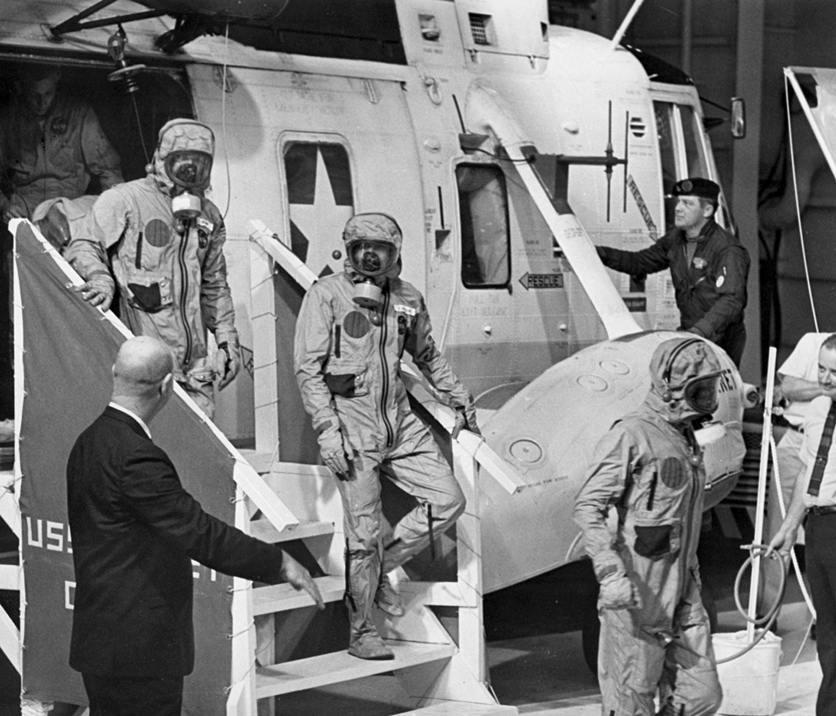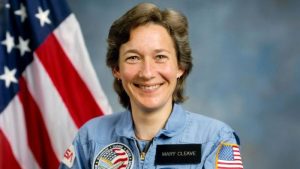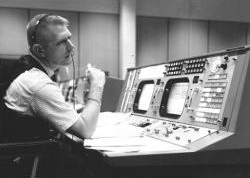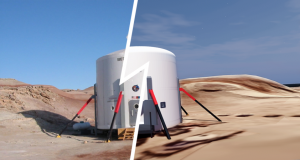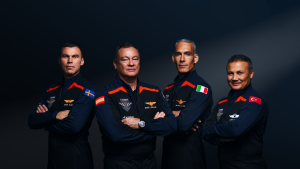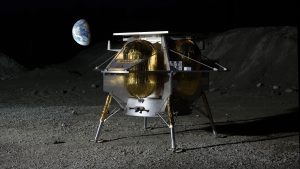Neil A. Armstrong
 The most famous American astronaut, Neil Armstrong is best known for being the first to set foot on the moon. But did you know…
The most famous American astronaut, Neil Armstrong is best known for being the first to set foot on the moon. But did you know…
Neil Armstrong is one of the first civilian astronauts. Neil Armstrong had been a Navy pilot, but had retired before applying to NASA as an astronaut. He was part of the second group of astronauts, the Mercury Seven having been chosen from among pilots in the Navy, Air Force and Marines.
He also flew the abortive Gemini 8. A thruster had malfunctioned, forcing them to make an early reentry.
First Man On The Moon
Wapakoneta, OH

Wapakoneta, Ohio, is most famous for being Neil Armstrong’s hometown. However, between Armstrong’s birth on August 5, 1930, and 1944, his family moved sixteen times, finally settling in Wapakoneta. He was the oldest of three children and his parents, Viola and Stephen, remembered him as a quiet and shy boy who never seemed to get upset about much. He was apparently not much of a troublemaker though his siblings suspected that he got out of things simply by being the favorite.
He was a bookworm and did so well in school that they promoted him to the third grade early. He was especially good at science and, in high school, was encouraged by science department head John Grover Crites. Crites recognized that Armstrong had an analytical mind and believed that he would do well in any field involving research.
Armstrong was active in Boy Scouts starting while his family lived in Upper Sandusky. Protestant minister J.R. Koenig helped form and lead the local troop after the U.S. entered World War II. As part of Scouting activity, Armstrong made airplane models to help the military improve their aircraft recognition efforts. Koenig was eventually replaced by Ed Naus and Steve Armstrong and they helped the troop start a monthly newspaper called The Pup Tent News.
Several legends would grow up around Armstrong’s youth. One fellow named Jacob Zint was an amateur astronomer who had built an observatory on his property. He would talk about how Armstrong came out to look through the telescope at the moon and they would discuss subjects like the possibility of life on other planets. Zint claimed that the young Armstrong fantasized about visiting the man in the moon. Armstrong didn’t recall being out at Zint’s place more than once and that had been carefully arranged by the scoutmaster so he could earn a badge. He never insisted that Zint stop telling his stories and Zint’s telescope is now in the Auglaize County Museum in Wapakoneta.
Like many families during the Depression, the Armstrongs didn’t have a lot of money for luxuries. His father had a job and that made Neil Armstrong seem rich to a lot of his peers. Armstrong found his first job at the age of ten, mowing the lawn at the Old Mission Cemetery in Upper Sandusky. He also worked in a bakery, helping make doughnuts and bread and scraping the dough mixer clean. When they moved to Wapakoneta, he found work at a grocery store. He saved a lot of his money for college.
Armstrong never went on more than a few dates and didn’t have a steady girlfriend in high school. An outing with his senior prom date turned into an adventure. He borrowed his father’s new Oldsmobile and took Alma Lou Shaw-Kuffner out on a double-date with Dudley Schuler and Patty Cole. They were going to go on an all-nighter out to Dayton but Armstrong began having second thoughts. What if they got in a wreck? So, they decided to go to a local amusement park, which was closed when they got there. They just drove around and found a late-night diner at three in the morning. On the way back home, Armstrong fell asleep at the wheel and they went into a ditch. All four of them tried to push the car out and the girls got grass stains on their dresses that they were hard-pressed to explain afterwards. A passing car pulled over and the driver helped them get it out of the ditch.
Armstrong graduated from high school at the age of sixteen and decided to take up flying. When recalling the Zint story, he would say that his dreams all had to do with airplanes, not space flight. He had taken his first airplane ride at the age of six years old and, during his senior year in high school, found three veteran army pilots who were willing to teach him how to fly. Receiving his private pilot’s license meant more to him than getting his driver’s license. When he heard that Chuck Yeager had broken the sound barrier in an X-1, he regretted not having been born a generation earlier. He felt that he had missed out on the real heroic age of aeronautics.
Purdue University
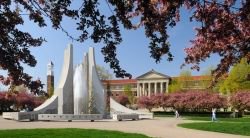 For all that, one era ends and another begins. As Neil Armstrong went into his freshman year at Purdue University, the National Advisory Committee for Aeronautics, NACA, was preparing new facilities to study transonics, supersonics and hypersonics. The transplanted German rocketry team at Redstone Arsenal also launched reconstructed V-2 rockets to an altitude of 70 miles, and then 83 miles, with the cargo of one monkey. Partial pressure suits were also seeing use at high altitudes for the first time. It became obvious to everybody except politicians in Washington, D.C., that outer space was the new high ground and the term “aerospace” was coined.
For all that, one era ends and another begins. As Neil Armstrong went into his freshman year at Purdue University, the National Advisory Committee for Aeronautics, NACA, was preparing new facilities to study transonics, supersonics and hypersonics. The transplanted German rocketry team at Redstone Arsenal also launched reconstructed V-2 rockets to an altitude of 70 miles, and then 83 miles, with the cargo of one monkey. Partial pressure suits were also seeing use at high altitudes for the first time. It became obvious to everybody except politicians in Washington, D.C., that outer space was the new high ground and the term “aerospace” was coined.
Armstrong chose to major in aeronautical engineering with his education paid for by the Navy through the Holloway Plan. At the time, the aeronautical engineering program at Purdue was very hands-on, though it would later gravitate toward theoretical. During his freshman year, Armstrong earned a 4.65 GPA out of a 6.00-point scale, the equivalent of a low B. Changes to the Holloway Plan led to an interruption in his college career at an inconvenient time. He was taking Thermodynamics I in fall of 1948 and wanted to follow it up right away with Thermodynamics II in the spring, but the Navy called him in early. He reported for Navy flight training in February 1949.
Flight Training
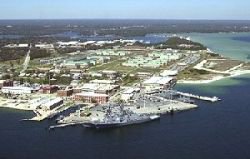
Neil Armstrong reported to Naval Air Station Pensacola in Florida, where he became one of forty midshipmen in Class 5-49. Pre-Flight training included four months of classes that included Aerial Navigation, Communications, Engineering, Aerology, and Principles of Flight. Many of the classes were taught by Marines. One particularly tough Marine named Lieutenant Mano was in charge of Physical Training. Neil Armstrong was a strong swimmer but otherwise not much for physical activity. He believed that Mano gave everybody low grades. The slightest lapse of discipline was penalized with demerits and disciplinary walking tours and everybody in the class walked at least one tour during Pre-Flight.
Armstrong finished Pre-Flight with the equivalent of a high “B” on the grading scale. Stage A of flight training took place at the largest of Pensacola’s auxiliary fields, Whiting Field. This stage consisted of eighteen dual instruction flights, a check flight, and then the student would fly solo in a North American SNJ. The instructor noted that Armstrong had difficulty with coordination and simulated emergencies but passed him on to Stage B anyway.
Stage B, manuevers, went reasonably well though Armstrong didn’t stand out. One instructor noted that he would probably make an average pilot. He rated mostly “average” or “above average” during Stage C, aerobatics. During Stage D, Armstrong had some trouble with altitude control but gradually improved. His two night flights, Stage E, went fine and he finished those five stages by Thanksgiving 1949.
Stage F, formation flying, went so poorly that Armstrong was assigned one increment of extra instruction. Stage G, gunnery, went well. In February 1950, he went out to Corry Field for Field Carrier Landing Practice. A runway had been painted to look like an aircraft carrier and he spent the next three weeks learning to follow the signals of a Landing Signal Officer (LSO). Armstrong’s trouble with altitude control came back but he improved with practice. Finally, he was ready for the equivalent of a final exam, six landing attempts on the light carrier USS Cabot. He succeeded and graduated from Basic Training to Advanced.
When asked to choose what kind of plane he wanted to fly, he requested single-engine fighters. He got his wish and took advanced training in an F8F-1 Bearcat. He received only one unsatisfactory mark during advanced training and, by July 1950, was ready to try carrier landings in the Bearcat. One classmate, Herbert Graham, remembered there was a competition between him and Armstrong to see who could get his six landings in first. Armstrong and Graham were tied, five to five, and Graham was forced to take a wave-off because the deck hadn’t been cleared. When Armstrong made his attempt, he became the first in his class to make all six landings. He graduated from training, now a fully fledged naval aviator.
Fighter Squadron 51
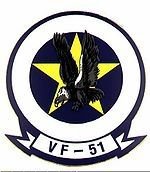
Armstrong asked for, and got, an assignment on the West Coast, with the Fleet Aircraft Service Squadron 7 at Naval Air Station San Diego. Officially, he was placed on pool status while he waited for assignment to an air group. In November 1950, he was assigned to Fighter Squadron 51 (VF-51), with Lieutenant Commander Ernest M. Beauchamp in command of the squadron. Beauchamp hand-picked most of the aviators in his squadron, even going toe-to-toe with the commander of Air Group 5 (CAG) to get four experienced lieutenant junior grade pilots for his core group.
Beauchamp never thought of Neil Armstrong as being a “mere” midshipman and Armstrong was promoted to ensign quickly enough. To the squadron commander, he was one of several gifted junior aviators in VF-51. When he wasn’t on duty, Armstrong’s hobbies included reading and carving models of planes and boats, one of which he gave to a friend so he could give it to his children. His interest in education set him apart and he could often be found demonstrating an aerodynamic principle or algebra problem to interested crewmen.
He logged more than 150 hours in VF-51′s F9F Panthers and impressed Beauchamp enough to be assigned as assistant education officer and assistant air intelligence officer before their ship, the Essex, received orders sending them to Hawaii. While in Hawaii, the planes were fitted with bomb racks and VF-51 became a ground attack squadron, a huge letdown for the aviators who hoped to face off against MiGs being flown by North Korea. The Essex went on to NAS Yokosuka in Japan after truce talks in Korea fell through.
Beebe, the Commander of the Air Group, often requested Armstrong as his wingman. This could be a risky honor because Beebe frequently risked his neck to take a second look at targets they had just bombed. Beauchamp once criticized him for keeping the air group out so long that they barely had enough fuel to get back to the Essex.
On his seventh Korean combat mission, Armstrong came close to losing his life. There are conflicting stories about what actually happened on September 3, 1951 but most of the important details agree. Armstrong’s targets included a bridge in a zone known as “Green Six,” not very far from the interior border of South Korea, when Frank Sistrunk from VF-54 was hit by anti-aircraft fire and crashed. At almost exactly the same time, Armstrong’s plane took damage and came so close to hitting the ground that he later commented, “Twenty feet from Mother Earth at that speed is awful doggone low!” Initially, it was believed that he had been hit by flak but later evidence suggested that he had run into a common booby-trap: a strung-up cable meant to take down low-flying aircraft. He certainly lost part of one of his wings though there was some disagreement on whether he lost two feet, three feet or six feet of it. He made it back to friendly territory and ejected near station K-3. He landed in a rice paddy with no injuries more serious than a cracked tailbone and a damaged helmet. Armstrong returned to the Essex the next day on a mail delivery boat. Some of the other members of the air group teased him a bit about owing the Navy a new helmet. Nobody ever knew what happened to his lost Panther.
Not even two weeks later, the Essex would see the worst disaster of the entire cruise. An F2H Banshee from VF-172, flown by John K. Keller, took damage in a mid-air collision, causing loss in aileron control and flaps. Beauchamp was in a landing pattern and may have seen the whole thing from the air. He certainly heard Keller call for a straight-in with something close to panic in his voice. He cleared the landing approach. Keller neglected to lower his tailhook, vital for catching one of the arresting wires and coming to a complete stop in the limited space of an aircraft carrier deck. Peering into the setting sun behind the plane, the tailhook spotter and LSO thought the tailhook was down. The Banshee bounced into the deck at 130 knots, went right over the heavy crash barriers, and slammed into a row of aircraft. Some of them had just landed and the pilots hadn’t yet left their airplanes. Others were fully fueled and the whole thing exploded. Seven men died and sixteen were seriously injured, most from burns. They were forced to push some of the planes overboard, including the Banshee with the dead pilot still inside. Beauchamp and his division landed on the nearby Boxer and stayed overnight while the Essex‘s crew sorted out the mess. Neil Armstrong was luckily on duty in the ready room and never saw the accident.
This and other losses were hard on air group morale. The worst of it was that they were only going after minor targets: bridges, trucks, trains, even a few oxcarts. It got so bad that some of the senior officers began to suspect sabotage. Five days after the Banshee accident, Essex returned to Japan for ten days of badly needed R&R.
Back to Korea
 Armstrong flew several air patrols and photo escort missions during the Essex‘s second tour in Korea. The air group lost only three pilots during that tour, mostly due to a slowdown in the fighting, and it got so boring that one pilot vented by jumping on an airplane wing and exclaiming, “Let’s go shoot something. Anything!”
Armstrong flew several air patrols and photo escort missions during the Essex‘s second tour in Korea. The air group lost only three pilots during that tour, mostly due to a slowdown in the fighting, and it got so boring that one pilot vented by jumping on an airplane wing and exclaiming, “Let’s go shoot something. Anything!”
The Essex returned to Yokosuka for refurbishing on October 31 and went back to Korea on November 12. With winter approaching, the weather became miserable and flying was impossible some days. When they did fly, they would often unload extra ordnance after a mission by dropping them on targets of opportunity. During their third tour, the air group had no casualties and, during their next layover in Japan, the Essex put on a Christmas party for Japanese orphans.
The Essex‘s fourth tour was the longest and nastier than the first one had been. Armstrong totalled more than 35 hours in the air. Morale plummeted, especially after the admiral announced that their replacement would be late relieving them. Two deaths hit them especially hard. One was Rick Rickleton, who was looking forward to returning to the U.S. after the war but was shot down and died in a fireball when his plane hit the ground. The other was Leonard Cheshire. Armstrong remembered long discussions with him on a variety of subjects that included philosophy, theology, literature and history when they were both off-duty. He was hit by anti-aircraft fire and went down with his plane in flames.
The fifth tour lasted only two weeks starting February 18, 1952, and Armstrong flew 13 missions. They headed back to the U.S. mainland with brief stops in Japan and Hawaii on the way. Like most in his air group, Armstrong brought home several medals, including the Air Medal, Gold Star and Korean Service Medal and Engagement Star.
Research Pilot

Once Armstrong returned to the States, he finished up his degree at Purdue and then considered his options. He stayed in the U.S. Naval Reserves until 1960, at first flying with the Naval Reserve Aviation Squadron 724 based just outside Chicago.
The idea of being a test pilot appealed to him. If he took a position with a private aircraft company like Douglas Aircraft, he could become a production test pilot, testing each plane of a particular model as it rolled off the assembly line. He could test new airplane models as an experimental test pilot. Armstrong was especially interested in becoming a research test pilot, with duties similar to experimental test pilots. He would help develop the science and technology of flight.
The National Advisory Committee of Aeronautics (NACA) was heavily involved in flight research and is most famous for being NASA’s predecessor along with its work with transonic and supersonic research. Most of NACA’s resources would be rolled up into the new agency. It was dabbling in some now-familiar space technology, including a centrifuge for testing the effects of multiple Gs, and some rocket-powered planes like the D-558-2 Skyrocket, X-1 and X-15 planes. Several legendary names in NASA worked for NACA in various capacities, including Walt Williams and Bob Gilruth. Armstrong put in his application at NACA’s High-Speed Flight Station, located at Edwards Air Force Base.

Edwards had no openings but passed the application around to other NACA facilities. The Lewis Flight Propulsion Laboratory in Cleveland, Ohio needed a test pilot and Armstrong was offered the job. It was the lowest-paying position Armstrong was offered but he took it anyway. It felt like a good fit for him and it meant he could stay in Ohio. He had met his first wife, Janet Shearon, at Purdue University and wanted to stay close to her.
Armstrong’s projects included new anti-icing systems for aircraft, and also investigating heat transfer at high Mach numbers. Mach numbers are multiples of the speed of sound and one T40 rocket launched by a test pilot reached Mach 5.18, or 5.18 times the speed of sound. Armstrong worked at Lewis for five months and then a position opened up at Edwards Air Force Base. Edwards was where Chuck Yeager had first broken the sound barrier in an X-1 plane and many of the revolutionary new planes like the X series were being tested. When asked if he would like to transfer out there, he jumped on it. He made one stop in Wisconsin on the way out west so he could marry Janet Shearon.
Neil and Janet Armstrong moved into an isolated cabin with no electricity and minimal plumbing. Installing modern conveniences was an ongoing project. For all that, they enjoyed the privacy. Their son, Eric, and first daughter, Karen, were born while they were living in that cabin. Armstrong carpooled to work with a few other NACA employees and, since being a test pilot wasn’t strictly an 8-to-5 job, was sometimes late picking up the others. He took some ribbing for it and one of the employees remembered that he gave as good as he got.
Armstrong was initially one of the youngest pilots there and started out flying chase in a P-51 Mustang or R4D. His job was to fly close to the plane being tested and observe its flight. It was fairly typical for one of the X planes to be attached to a B-29 bomber’s underbelly and flown up to a height of 30,000 feet or more. Then, it would be dropped and fly on its own. With a plane model this new, things could go wrong in a hurry. The rocket engine on the X-1A had a faulty gasket that exploded when the test pilot pressurized the liquid oxygen and alcohol that served as fuel. One test pilot barely had time to scramble out of the plane into the bomb bay of the B-29 before they had to jettison the X-1A.
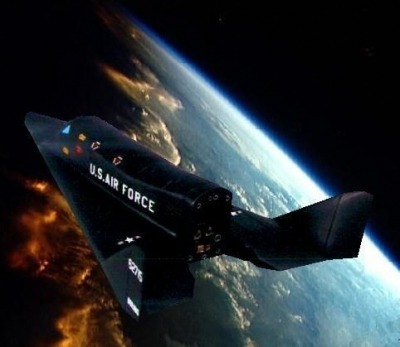
Two projects on the drawing board were the X-15 and the Dyna-Soar, both meant to test the possibility of taking manned winged vehicles up to hypersonic speeds above the atmosphere. This was about the same time the more famous Mercury Project was using rockets to send astronauts up in capsules whose shapes reminded Gus Grissom of the Liberty Bell. Neil Armstrong took one fighter jet up to 90,000 feet, a point at which atmospheric drag was minimal and Newtonian physics began to take over. He had to shut off his engine at above 70,000 feet and manuever using jets of hydrogen peroxide. As he dived, he passed Mach 1.8 and the atmosphere became thick enough that he could restart his engine. Then, he made a routine landing.
The altitude record wouldn’t last. Chuck Yeager lost control of an NF-104A while flying up to 108,000 feet and was injured in the crash, and test pilots in X-15s successfully flew up to 200,000 and then 264,000 feet in pressure suits resembling those the Mercury astronauts wore.
In April 1962, Armstrong himself flew an X-15 up to 207,500 feet, or about 40 miles high. Until his first mission as an astronaut, it was a personal altitude record. He was testing a G limiter he had helped design and, while dropping back down into the atmosphere, lifted the nose of the plane just enough to let it balloon up to 140,000 feet. He ran into trouble and tried to turn, but there was not enough atmosphere. He finally managed to drop back down near Pasadena, forty-five miles from Edwards. He barely made it back to the base and landed in one of the dry lake beds. His fellow pilots kidded that he barely missed the diminutive Joshua trees that dotted the area.
There was a big debate about the best landing technique for the X-15. Another test pilot named Scott Crossfield preferred landings similar to the technique used to land on aircraft carrier decks but nearly bought it in two out of three tries. One method called for a high-speed, straight-in approach. Armstrong disliked both and developed a method that called for a spiralling descent from 40,000 feet. Armstrong’s technique was adopted by North American Aviation for their F-104, and Armstrong co-authored two papers about it.
Armstrong averaged ten flights a month until he joined the astronaut corps in September 1962. He consulted for the X-20 “Dyna-Soar” program run jointly by NASA and the Air Force and, for a while, it was a competition to see whether the Mercury Program or the Dyna-Soar would make it into space first. He might have stayed on as a test pilot, but a tragedy would lead him to consider a change of pace.
Muffie
During his teen-age years, Armstrong had a friend named Fred Fisher, who had a little sister named Karen “Cookie” Fisher. Cookie adored Armstrong, mostly because he paid attention to her, unlike most of her brother’s friends. Armstrong remembered Cookie and decided to name his daughter Karen, whom they affectionately called Muffie.
While on a trip to Seattle on Dyna-Soar business, Armstrong took his wife Janet, four-year-old Rick, and two-year-old Karen along. Karen and Rick enjoyed the public park near Lake Washington and, while leaving the park on June 4, 1961, Karen fell down. It seemed like a minor thing. She had a little knot on her head and a nosebleed and Janet thought she just had a minor concussion. A Seattle pediatrician recommended a thorough check-over and their regular doctor in California just recommended keeping an eye on her and bringing her back in a week.
Janet gave swimming lessons at a local pool and the mother of one of the students noticed that Karen was getting worse. She took Karen to the hospital for tests and called Armstrong. They diagnosed a rare brain-stem tumor and tried X-ray treatment. She lost, then gradually regained, her balance and, for the next month and a half, she seemed to be doing better. Afterwards, she had a relapse and they tried cobalt treatment, but it didn’t help. She went downhill fast and made it through Christmas 1961, finally succumbing to pneumonia on January 28, 1962.
It was rough on both Janet and Neil Armstrong. Neil Armstrong tried to internalize it and bury his grief in his work. He did not talk about Karen much, even to his closest friends. Janet, especially, was hurt by Neil Armstrong’s silence and it probably contributed to their divorce a few decades later.
After Karen’s death, Armstrong was involved in a series of mishaps that made some people wonder whether his personal life was affecting his flying. He didn’t think so, and he was certainly not the only test pilot to have difficulties with revolutionary planes like the X-15. One explosion in June 1960 left pieces of the rocket engine scattered across the landscape; the pilot was lucky to survive.
Before too long, the remaining family’s entire lives would change. NASA was looking for a second group of astronauts to follow the Mercury Seven, so Neil Armstrong decided to apply. He never speculated about whether the loss of his daughter was a factor in this decision though sources closest to him suspected that he needed something positive to focus on.
Astronaut Candidate
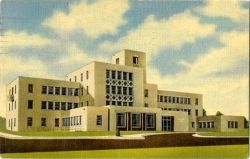
There were a few people in Houston who remembered Armstrong from the NACA days, including Walt Williams and Dick Day. They encouraged him to apply for the second group of astronauts. His application arrived a week after the official deadline, possibly because he was on vacation in Seattle while it waited on his desk at Edwards. Without a word to the rest of the selection committee, Dick Day slipped it in with the rest of the applications. He didn’t discuss it with very many people at Edwards and many of his friends were surprised when his name was among those who had been selected.
Chris Kraft, a flight director at NASA who had also worked for NACA, hardly knew Armstrong but didn’t think anything of the string of bad luck Armstrong had recently had while flying. When he found out that Armstrong’s daughter had died, he just decided that it might have affected his performance for the short term but it would have worked itself out and perhaps the flight surgeon and chief test pilot were partly at fault for not giving Armstrong a break from flying for a while.
The physical and psychological tests that every astronaut candidate had to go through were demanding but had been refined from what the Mercury Seven had endured. Holdovers included the blackout chamber that the candidates had to sit in for two hours. Armstrong tried to time it using the song “Fifteen Men in a Boardinghouse Bed.” The Mercury astronauts might also have recognized torture devices like the syringe they used to spray ice-cold water in their ears and a heat chamber that could get as high as 145 degrees Farenheit. Of the Mercury astronauts, Armstrong already knew Wally Schirra and Gus Grissom from Edwards and got to chat with a couple of them about the program.
During the four months between his application and the announcement, he kept busy with his work at Edwards. He flew test flights in the F-104, flew chase for some X-15 flights, received an award at an IAS event in Los Angeles, and presented a paper on an in-flight simulator that would evolve into the Lunar Landing Training Vehicle (LLTV) at an AGARD meeting in France.
He got the call from Chief Astronaut Deke Slayton that he had been selected. There was some speculation that NASA had wanted a civilian test pilot for the public relations but NASA officials denied it. His association with NACA, and then NASA, as a test pilot probably counted for more than the fact that he was a civilian. He was asked to discuss it with no one but his immediate family until the public announcement.
I’ve Got A Secret
Not long after Armstrong was selected, his parents appeared on a 1960s game show, I’ve Got A Secret. If contestants could stump a panel of celebrities, they could win a prize of $80. The panel’s first guess was that the Armstrongs’ son was Jack Armstrong, “The All-American Boy,” from an adventure series that had been popular in the 1930s and 1940s. Then, they correctly guessed that the second group of astronauts, including Neil Armstrong, had just been announced earlier that day. Armstrong didn’t get to see the program.
The New Nine
On September 15, 1962, nine people checked into Houston’s Rice Hotel with the alias of Max Peck. Neil Armstrong was Max Peck Number Nine. The New Nine’s official first meeting took place the next morning, along with Walt Williams, Bob Gilruth, Shorty Powers and Deke Slayton. As the head of the Astronaut Office, Slayton would be their immediate boss. Armstrong and Elliot See were both civilians with Navy backgrounds. Charles “Pete” Conrad Jr., James Lovell Jr., and John W. Young came from the Navy. From the Air Force were Thomas Stafford, Frank Borman, James McDivitt, and Edward White. Several within NASA would come to regard this as the best group of astronauts they had ever assembled.
During this first meeting, Slayton gave them a warning about accepting freebies that made Gilruth blush. Public Affairs Officer Shorty Powers briefed them on the press conference, and then the nine new astronauts faced an 1800-seat auditorium full of reporters. NASA was better prepared for the expected media attention than they had been for the announcement of the Mercury Seven. This time, there was no John Glenn to give a spectacular speech to the press and the nine simply gave one- or two-sentence answers to most of the questions. Neil Armstrong certainly was less than impressed by the event: “[T]he questions at the press conference were typical, fairly unsophisticated questions, with answers to match.”
While Janet Armstrong prepared for the move to Houston, he spent the rest of September 1962 flying at Edwards. This included work on a paraglider known as the Parasev. If it had proven feasible, something like it might have been used for reentry during the Gemini program. Development on the paraglider became problematic due to technical issues and NASA was committed to water landings at the time anyway, so it was canceled.
With the rest of the New Nine, he watched Wally Schirra’s Sigma 7 launch on October 3. Then, he was officially reassigned to the Manned Spacecraft Center and carpooled with Elliot See for the 1,600-mile trip. To help his family move, he traded in both the cars he owned at the time for a spacious station wagon. The Armstrongs partnered with Ed White’s family to buy three adjacent lots and split the center one down the middle. Many astronauts lived in the same neighborhood and their families became a close-knit community.
An Astronaut’s Life
The Nine jumped right into work, starting with tours of contractors like Lockheed Aircraft Corporation and the Martin Company and a visit to Huntsville, Alabama, where they met the rocket team headed by Doctor Wernher von Braun. The company bosses often treated them to huge spreads of food and drink. It was something of a novelty to be treated like a celebrity.
Basic astronaut training included classroom courses on a variety of subjects like astronomy, orbital mechanics and spacecraft design. They had a modified KC-135 that came to be known as the “Vomit Comet” for zero-g training. Armstrong teamed up with John Glenn for survival training, an exercise that wasn’t always popular with the astronauts. When they went down to Panama for jungle training, Armstrong teamed up with John Glenn and carved “Choco Hilton” on the shelter they made, referencing some friendly members of the Choco Tribe that they had met.
Armstrong was introduced to helicopters for the first time in November 1963. Theoretically, flying a helicopter would better prepare astronauts for landing a Lunar Module on the Moon. It was less risky than the Lunar Landing Training Vehicle turned out to be but Armstrong thought it wasn’t as effective as a training tool, either. Not even an LLTV crash in which Armstrong was forced to eject changed his mind.
When handing out specializations, Deke Slayton did not miss the fact that Armstrong already had some experience with simulators at Edwards. Flight simulators were still in their infancy but already seen as a vital training tool at NASA. They weren’t perfect. NASA’s simulators had a bad habit of crashing in the middle of a run, and they didn’t do a very good job of simulating conditions on the day side of an orbit. Armstrong’s job was to help make sure the simulators accurately represented conditions they might encounter in actual space flight. With his pilot’s perspective, he helped the technicians make the simulators look more realistic to the pilot-astronauts.
Armstrong was the first of the New Nine to take on administrative duties at the Astronaut Office. Slayton put him in charge of operations and training. They were starting to put together the crews for the Gemini missions and Slayton asked him to help determine how many crews would be needed at any given time. Armstrong got a list of the planned launch dates for the Gemini and Apollo missions and worked backwards from each date to determine how long each crew would have to spend preparing and training for each flight. When preparations for Apollo began to overlap with Gemini, the number of needed crews grew to the point where NASA officials decided to select a third group of fourteen astronauts that included Buzz Aldrin and Michael Collins.
House Fire
Even before the Apollo 1 fire issued a painful reminder of the risks of space flight, tragedies and near-tragedies began to strike the astronaut corps. Elliott See, Charlie Bassett and Theodore C Freeman were lost in accidents involving NASA’s fleet of T-38 planes. In the spring of 1964, the Armstrong family nearly lost their lives in a house fire.
Janet Armstrong woke in the middle of the night, smelled smoke, and woke Neil Armstrong. He investigated and yelled to Janet that the house was on fire. She tried to call the fire department with no luck, and then tried two emergency numbers. She ended up calling their neighbors, the Whites. Ed White had nearly qualified for the Olympics in the high hurdles before becoming an astronaut and leaped over the six-foot fence to help.
In the meantime, Neil Armstrong went to save their children. They had a ten-month-old son, Mark, whom he passed through a window to Ed White. Then, he went for six-year-old Rick. He had to hold a wet cloth over his face. He described those twenty-five feet he had to cross to Rick’s bedroom as “the longest journey I ever made in my life.” Rick was still alive and suffered no injury worse than a burn on his thumb. Armstrong put the cloth over Rick’s face and made it out to the backyard.
With White’s help, he pushed the cars out of the garage. The body of the Corvette he had gotten at a discount from a friendly Chevy dealer took some heat damage. They tried to fight the fire with hoses until the fire department arrived. The house burned to cinders and they lost many valuable mementos, mostly pictures and new furniture. They found Armstrong’s boyhood collection of model airplanes, most of them melted and twisted from the heat. But they were just glad they had made it out alive. They stayed at the Whites’ house for a few days, and then found an apartment where they lived until they could rebuild their house. Friends stepped up to the plate to help replace needed items they had lost in the fire.
Life went on, and so did Armstrong’s career as an astronaut. Neil Armstrong’s first crew assignment was as the backup commander of Gemini Five, with Elliot See as the backup pilot. If the prime crew of Gordon Cooper and Charles Conrad couldn’t fly, they would have stepped up to the plate. It proved unnecessary and Gemini Five made it only an hour short of the eight-day goal with a faulty fuel cell. Then, Neil Armstrong drew the assignment as the commander of Gemini Eight with Dave Scott as pilot.
Gemini 8
March 16, 1966
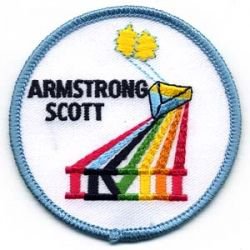 The primary goal of Gemini XIII was to rendezvous and dock with an automated spacecraft called Agena. This would be the first actual docking. Previous problems with the Agena craft had led to a change of goals for Gemini VI and they had successfully rendezvoused with Gemini VII. The plan also included an EVA by Dave Scott and a test of a digital computer to assist with guidance and navigation. Digital computers were still brand-new and the Gemini program was one of the first practical applications. The challenge appealed to Armstrong as a pilot.
The primary goal of Gemini XIII was to rendezvous and dock with an automated spacecraft called Agena. This would be the first actual docking. Previous problems with the Agena craft had led to a change of goals for Gemini VI and they had successfully rendezvoused with Gemini VII. The plan also included an EVA by Dave Scott and a test of a digital computer to assist with guidance and navigation. Digital computers were still brand-new and the Gemini program was one of the first practical applications. The challenge appealed to Armstrong as a pilot.
The Agena lifted off without problems at ten o’clock am, prompting a cool “Very good” from Neil Armstrong as he waited for liftoff in the Gemini. Gemini VIII lifted off at 11:40 am. Armstrong had seen the curvature of the Earth from forty miles up while still working on the X-15, but this was a first for Dave Scott. He asked his commander, “Hey, how about that view?”
“That’s fantastic!” Armstrong agreed.
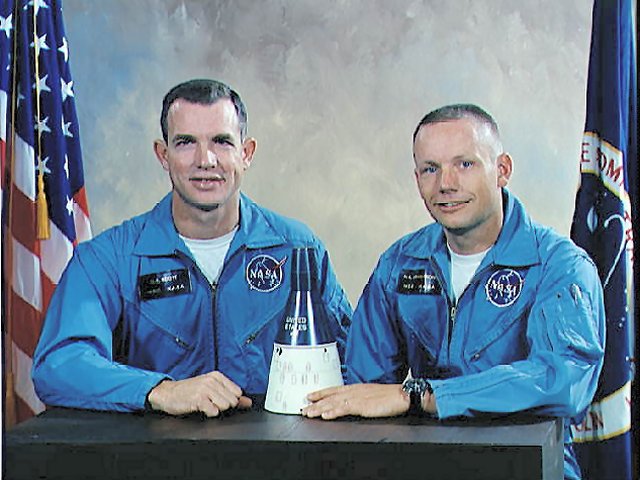
Their duties did not leave much time for sight-seeing. When they did get a chance to look out the window, they spotted Hawaii and Armstrong picked out his old base at San Diego. Armstrong aligned the Gemini’s inertial platform, three gyroscopes that would keep track of yaw, roll and pitch angles and provide the spacecraft with some sense of direction. With a quick firing of the thrusters, he maneuvered the Gemini into the same orbital plane as the Agena’s. If the plane was off by even a little, they would have missed their target. They aligned their platform again for another burn, this time a simple repositioning in their plane. They found time for a meal of reconstituted chicken casserole and fruit juice before the next plane-change adjustment.
 They began to catch up with the Agena, double-checking the computer’s results with an on-board chart and with computations on the ground. As they had found out when Gemini 5 splashed down 100 miles off target, seemingly small errors in their computations could have large results. The Gemini spacecraft gained a radar lock at 2:20 pm Houston time and, slightly over three and a half hours later, Armstrong and Scott were flying alongside the Agena. They flew around the automated spacecraft, taking pictures as they went. Though Dave Scott was technically the pilot, Armstrong did most of the actual flying at this point. He would have given Scott a chance to practice later if they had gotten the time.
They began to catch up with the Agena, double-checking the computer’s results with an on-board chart and with computations on the ground. As they had found out when Gemini 5 splashed down 100 miles off target, seemingly small errors in their computations could have large results. The Gemini spacecraft gained a radar lock at 2:20 pm Houston time and, slightly over three and a half hours later, Armstrong and Scott were flying alongside the Agena. They flew around the automated spacecraft, taking pictures as they went. Though Dave Scott was technically the pilot, Armstrong did most of the actual flying at this point. He would have given Scott a chance to practice later if they had gotten the time.
At 6:30, they were ready to dock. Armstrong inched the Gemini toward the Agena and, after a slight pause while Mission Control checked systems, he made the final connection. “Flight, we are docked! Yes, it really was a smoothie.”
The CapCom radioed up: “Roger. Hey, congratulations! This is real good.”
Scott chimed in, “You couldn’t have the thrill down there that we have up here.”
Capcom snorted. “Ha, ha, ha!”
They had no serious problems at first. Houston noticed some difficulties with sending commands up to the Agena and the velocity meter appeared to have gone offline. They weren’t very worried about it and had CapCom tell the Gemini 8 crew to send a Command 400 if the Agena started acting like a bucking bronco. A few minutes later, the tracking network lost Gemini 8′s signal. The bank angle began to go and Armstrong tried correcting it with the Orbit Attitude and Maneuvering System (OAMS). Because of the Agena’s history of faults, they thought it was a problem with the other spacecraft. They undocked and quickly realized that the problem was with the Gemini. A thruster was stuck open, causing them to go into a spin. They were making one complete revolution every second.
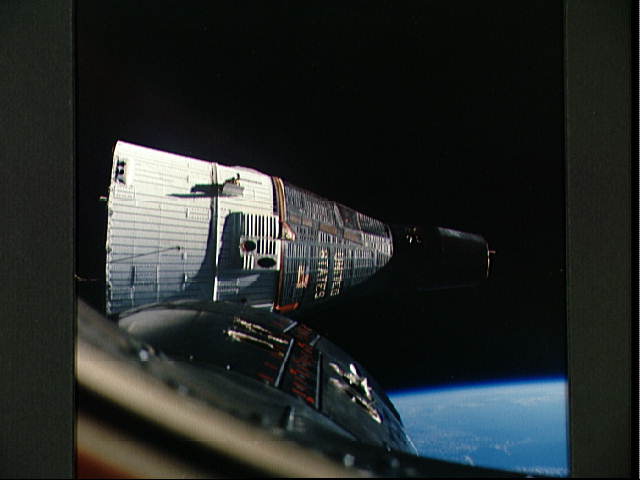 When they regained contact with the tracking network, Scott radioed back, “We’ve got serious problems here. We’re tumbling end over end. … We’re disengaged from the Agena.” Armstrong could only think of one solution, activate the reentry control system (RCS). They managed to regain control of the Gemini. The Agena was nowhere in sight.
When they regained contact with the tracking network, Scott radioed back, “We’ve got serious problems here. We’re tumbling end over end. … We’re disengaged from the Agena.” Armstrong could only think of one solution, activate the reentry control system (RCS). They managed to regain control of the Gemini. The Agena was nowhere in sight.
According to mission rules, once the RCS was activated, they would have to come back to Earth as soon as possible. Flight Director John Hodge calculated that they should splash down in an area about 500 miles east of Okinawa. Armstrong and Scott were not thrilled at having to come home early and even less happy that they would have to come down, as Armstrong put it, “way out in the wilderness.” It meant they would have to wait a while for pickup, in a spacecraft that already had a reputation for not making a very good boat. More than two hours later, frogmen from the recovery ship Leonard Mason opened the hatch. Armstrong was on board the destroyer first and Dave Scott, an Air Force officer, had to get an assist to make it up the Jacob’s ladder. Armstrong was especially unhappy that they hadn’t been able to complete their objectives and Scott missed his chance at EVA experience.
Wally Schirra joined them and, for once, the class clown of the Mercury astronauts wasn’t responsible for the comedy that played out when they returned to Okinawa. A large crowd had gathered for their arrival, along with a band and all kinds of banners. The Leonard Mason tried to pull in, with all the observers waving their banners and the band playing away. But a big wave pushed the destroyer right back out to sea. The banners came down and the band paused. They made a second approach, and the band started playing. Then, the sea pushed them right back out again. The embarrassed captain made the necessary adjustments and they were finally able to dock. By then, the band was starting to tire and some of the crowd had dispersed. Schirra was chuckling, and Armstrong might have enjoyed the joke better if he hadn’t been so upset about the early termination of their mission.
Post-Flight
A Mission Evaluation Team ruled that pilot error was not a factor in the emergency on Gemini VIII. A few other astronauts were disgruntled and some implied that they could have done better if they were up there. Much later, one even accused him of parlaying Gemini VIII into the first lunar landing. That was unlikely. Deke Slayton was in charge of crew assignments and would have considered Gemini VIII to be a minor issue at best by the time he chose the first man who would walk on the moon. In any case, it didn’t seem to affect his career as an astronaut much and Armstrong served on the backup crews of Gemini XI and Apollo 8 in due course.
Armstrong was annoyed at the press for hyping the thruster malfunction. He put in a call to Life magazine and the editor agreed to tone it down, though Armstrong was especially irked at them for not gaining the approval of NASA and the astronauts for their finalized article.
Armstrong and Scott both received NASA’s Distinguished Service Medal and Armstrong got a raise in pay, making him the highest paid astronaut at the time. By that time, the New York City ticker tape parades and dinners at the White House were a memory. Armstrong and his wife did attend a celebration at Wapakoneta. Armstrong wasn’t in much of a mood for celebrating but made the best of it. He received several gifts, including a lifetime membership to the Elks Lodge, and gave away little flags that he had taken on board Gemini VIII.
Goodwill Tour
By Autumn 1966, it had been a while since Neil Armstrong got a break from his astronaut’s duties. President Nixon’s idea of a goodwill tour in Latin America in October 1966 provided a welcome change of pace. The Armstrongs spent 24 days visiting 14 cities with Dick Gordon and George Low, who had recently become the head of the Apollo Applications office.
The people in all eleven countries they visited were certainly enthusiastic about the chance to see astronauts up close. At one point, George Low recorded, the crowds thronged around the motorcade, slowing progress to a snail’s pace. Armstrong and Gordon spent quite a bit of time signing autographs and shaking hands. The local security forces didn’t always seem to be prepared for the crowd’s response and they did have some minor incidents with local Vietnam protesters.
Armstrong artfully deflected any personal questions, preferring to discuss the technological and scientific aspects of the Gemini program. He had made an effort to learn Spanish and a little Guarani for the trip and Low was certainly impressed by his ability to talk to a crowd. The State Department and NASA officials were pleased by the positive results of the goodwill tour.
Apollo 1
 On January 27, 1967, the space program mostly seemed to be on track. There was even hope that they would be able to put a man on the moon a couple of years early. One astronaut didn’t see it that way. Gus Grissom had repeatedly voiced concerns over problems with the Apollo spacecraft but nobody seemed willing to listen. Finally, in frustration, he took a lemon from a tree in his back yard and hung it on the spacecraft. A week later, he was dead along with fellow astronauts Roger Chaffee and Ed White in the Apollo 1 fire.
On January 27, 1967, the space program mostly seemed to be on track. There was even hope that they would be able to put a man on the moon a couple of years early. One astronaut didn’t see it that way. Gus Grissom had repeatedly voiced concerns over problems with the Apollo spacecraft but nobody seemed willing to listen. Finally, in frustration, he took a lemon from a tree in his back yard and hung it on the spacecraft. A week later, he was dead along with fellow astronauts Roger Chaffee and Ed White in the Apollo 1 fire.
Armstrong was attending the signing of a treaty governing the exploration and exploitation of space with a few fellow astronauts on that day. After the official ceremony, they mingled for a while, and then most of them returned to their respective hotel rooms. The person at the front desk gave him a message to call the Manned Spacecraft Center. The man on the other end of the line gave him the news about the fire and warned him to disappear until further notice so reporters couldn’t get hold of him.
The investigation of the fire took a matter of weeks and it would be months before they started flying in space again. Armstrong and many of his colleagues were devastated. They felt that a ground test that should have been low-risk was no place for three top-notch pilots to die. Armstrong had lost a friend and the neighbor who had helped him battle the flames when his house burned down. He and Janet attended the funerals. It was one of the few major space-related accidents he wasn’t asked to help investigate. Frank Borman represented the astronauts instead. Ten weeks later, the committee turned in its formal report and engineers began fixing the problems that had led to the fire.
A week after the formal report was turned in, Deke Slayton called a meeting with a select group of astronauts that included Armstrong, Michael Collins and Buzz Aldrin. Slayton announced, “The guys who are going to fly the first lunar missions are the guys in this room.” According to the rudimentary plan taking shape, Apollo 11 would have been the full-dress rehearsal of the landing. Apollo 12 would have been the actual landing.
Lunar Landing Training Vehicle
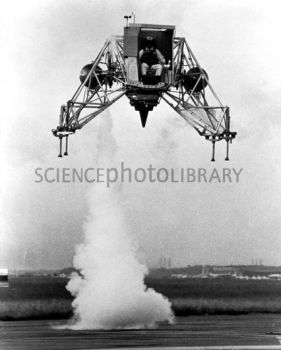 Even before the Apollo 1 disaster, Armstrong and Buzz Aldrin were studying the matter of lunar landing simulators. They could be making simulated lunar landings at Langley Field one day and be fitted for an LLRV ejection seat at contractor Weber Aircraft the next. They spent a lot of time in T-38s during this time.
Even before the Apollo 1 disaster, Armstrong and Buzz Aldrin were studying the matter of lunar landing simulators. They could be making simulated lunar landings at Langley Field one day and be fitted for an LLRV ejection seat at contractor Weber Aircraft the next. They spent a lot of time in T-38s during this time.
The difficulty in developing devices that would fly like lunar landers primarily lay in the fact that they were trying to simulate lunar conditions on Earth. The Moon has no significant atmosphere and, in Earth’s atmosphere, they had to put up with winds and gusts. One option was a device called the Iron Cross, which didn’t actually fly but was meant for tests in near-vacuum conditions. Another idea was to carry the lunar simulator on a larger vehicle that would simulate conditions on the Moon. The result of that one looked to Armstrong like a Campbell’s Soup can with legs and an engine. Bell Aerosystems provided blueprints and two models of the Lunar Landing Research Vehicle (LLRV) they had developed.
The higher-ups in NASA didn’t like the risky LLRV and kept looking for a better alternative. A slightly improved version, called Lunar Landing Training Vehicles (LLTV), were funny-looking contraptions to pilot-astronauts used to ordinary jet planes. They were based on still-experimental vertical takeoff and landing (VTOL) technology and looked like a plumber’s idea of what a lunar module might look like. Because of their appearance, they picked up nicknames like “the flying bedstead” and “the pipe rack.”
Helicopters were still in use as trainers and Armstrong was not the only astronaut to wonder about NASA’s reasoning. Bill Anders felt pretty much the same way: “That was, in a sense, almost bad training, flying helicopters.” The helicopter was good for judging trajectories and visual fields but the control system was different from what they had planned for the Lunar Module. Even after he had to eject from an LLRV that crashed, Armstrong continued to defend its use as a training tool. In fact, many of his colleagues were impressed by the cool attitude he had about the ejection. He simply returned to his desk to do some paperwork. Alan Bean asked about it and he only said, “I lost control and I had to bail out of the darn thing.” Bean could only think that if it had been anybody else, they would likely have been telling the story over drinks instead of just returning to their office!
Apollo
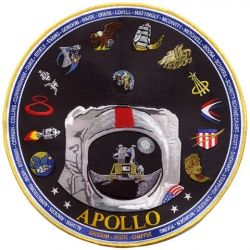 The Apollo 1 fire had threatened the Kennedy plan of putting a man on the moon by the end of the decade. It would take some bold action to get back on track and, after the successful Apollo 7 flight, NASA officials decided to send Apollo 8 into lunar orbit.
The Apollo 1 fire had threatened the Kennedy plan of putting a man on the moon by the end of the decade. It would take some bold action to get back on track and, after the successful Apollo 7 flight, NASA officials decided to send Apollo 8 into lunar orbit.
Neil Armstrong was the backup commander and woke early to have breakfast with the prime crew. At three in the morning, he didn’t have much of an appetite for the traditional filet mignon and scrambled eggs, so he stuck to coffee. While the prime crew suited up, he went out to Launchpad 39A to check the controls in the cockpit. This was going to be the first manned launch of the Saturn V. The unmanned test flights, Apollo 4 and Apollo 6, had been qualified successes. The main problem was the amount of pogo, a vibration caused by combustion instability. Engineers were sure they had pretty much solved the problem but Armstrong still thought it was a bold move to make the next Saturn V launch a manned one.
After launch, Armstrong watched the flight’s progress until well after the trans-lunar injection. Apollo 8 was well on its way to the moon. He returned to Houston and spent a lot of time at Mission Control. Deke Slayton found him there and conferred with him about his next assignment, Apollo 11. No one knew for sure whether Apollo 11 or 12 would be the first lunar landing. If anything went wrong in Apollo 8, 9 or 10, the actual landing could be pushed back to allow for more test flights.
During Armstrong’s conversation with Slayton, the subject of who his crewmates would be came up. It was possible that Buzz Aldrin could have been bumped in favor of Jim Lovell. Aldrin had occasionally gotten snipped at by other astronauts for making unsolicited suggestions, but perhaps Armstrong didn’t think it would be much of a problem. Replacing Aldrin would have meant it would be that much longer before Lovell got a chance to command an Apollo mission and Armstrong thought he deserved the chance. So, Armstrong decided not to pull him out of sequence and he ended up commanding Apollo 13. Armstrong never told either Lovell or Aldrin about his conversation with Slayton.
Apollo 8 made it back with no problems, and then Apollo 9 successfully tested the Lunar Module. Some inside and outside NASA wondered why they couldn’t make Apollo 10 the first actual landing, but those who favored a “dress rehearsal” held firm and 10′s Lunar Module got down to five miles above the lunar surface without a problem. Apollo 11 would be the first actual landing attempt.
The Apollo 11 Channel
Who’s On First?
At the press conference that introduced the Apollo 11 crew, the press asked the inevitable question: “Which of you gentlemen will be the first man to step out onto the lunar surface?” Armstrong didn’t quite seem to know how to handle that one and fielded it to Deke Slayton. Slayton answered: “I don’t think we’ve really decided that question yet. … I think which one steps out will be dependent upon some further simulations that this particular crew runs.”
It got to be quite a serious issue. Aldrin thought he had a good chance of being first and tried to talk to Armstrong about it. Armstrong was non-committal. When Aldrin went to some of the other astronauts for advice, many of them thought he was trying to lobby to be first and shut him down. Slayton got wind of Aldrin’s actions and told him that Armstrong would be out first, because he had seniority and he was the mission commander. It was a reversal of the roles they had established during Gemini. The commander had stayed in the cockpit while the pilot conducted EVA work.
They were certainly both aware that the first person to set foot on the moon would be the more famous. There was some speculation among outsiders that Armstrong had pulled rank. He denied it and insisted that the choice had entirely been in the hands of NASA officials. Several NASA insiders like Chris Kraft confirmed it. He had held a private meeting with Slayton, Bob Gilruth and George Low and they all agreed. Armstrong was exactly the kind of person they wanted to be first on the moon.
Training For Apollo 11
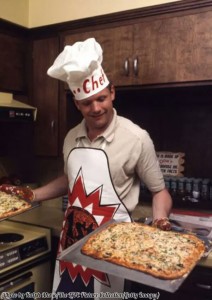 Armstrong wasn’t going to let the issue of who stood on the lunar surface first affect the work of training for the mission. Aldrin was probably lucky in this regard. Some later lunar mission commanders would have been less patient and preparing would have been stressful enough without the mission commander sparring with his Lunar Module pilot.
Armstrong wasn’t going to let the issue of who stood on the lunar surface first affect the work of training for the mission. Aldrin was probably lucky in this regard. Some later lunar mission commanders would have been less patient and preparing would have been stressful enough without the mission commander sparring with his Lunar Module pilot.
Being an astronaut is a more than full-time job even when they aren’t preparing for a mission and they were easily putting in more than sixty hours a week training and handling the details of preparing for the mission. Even so, Neil Armstrong did find time for family, as we see in the picture on the left of him preparing a couple of homemade pizzas. This picture was apparently taken a few months before the Apollo 11 mission.
As the two who would walk on the moon, Armstrong and Aldrin often trained separately from the command module pilot, Michael Collins. While he worked on potential rendezvous scenarios in his own simulators, the two future moonwalkers practiced in the lunar module simulators and rehearsed setting up experiments and collecting samples in a mock-up of the lunar surface. Armstrong admitted later that they had been tempted to sneak a piece of limestone along to bring back as a sample.
Even though Armstrong wasn’t the confrontational type, the simulators did cause one documented argument among the crew when Armstrong blew a simulation and “crashed” the lunar module. Buzz Aldrin was not happy and told Michael Collins about it in the crew quarters later that night. Armstrong came out of his bedroom in his pajamas. According to Aldrin, he was annoyed about being woke up. Collins thought he was upset about being criticized over what should have been a learning experience and left the two of them to hash it out.
After the successful Apollo 10 mission, Deke Slayton had another chat with Armstrong: “How do you feel? Are you ready?” Armstrong told him, “Well, Deke, it would be nice to have another month of training, but I cannot in honesty say we have to have it. I think we can be ready for a July launch window.” That set the launch for July 16, 1969, with July 20 set as the date for the first landing.
CBS Coverage – Apollo 11 Launch
Launch Day
July 16, 1969
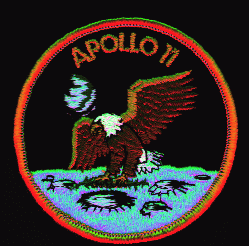 Launch days typically started early for the astronauts and, shortly after 6:00 am, Neil Armstrong, Buzz Aldrin and Michael Collins were getting into their pressure suits with the help of technicians. The pressure suit was one technology that had improved steadily since Kennedy put America on course for the moon. Compared to the suits Armstrong had worn while flying in F-104s and X-15s, these ones seemed positively roomy.
Launch days typically started early for the astronauts and, shortly after 6:00 am, Neil Armstrong, Buzz Aldrin and Michael Collins were getting into their pressure suits with the help of technicians. The pressure suit was one technology that had improved steadily since Kennedy put America on course for the moon. Compared to the suits Armstrong had worn while flying in F-104s and X-15s, these ones seemed positively roomy.
At 6:27 am, the crew headed out to the transfer van that would take them to Launchpad 39A, eight miles away. Their view of the Saturn rocket, the most powerful rocket ever built up to that point, was certainly impressive. The rocket, plus its payload of the command, service and lunar modules, stood 363 feet tall and would produce 7.5 million pounds of thrust when it lifted off. Armstrong was certainly aware of the dangers. To speed up the process, this rocket had been developed using the “all-up” method, combining tests of all three stages, instead of incrementally testing each stage separately as Armstrong would have preferred.
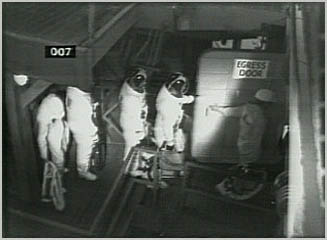 The White Room was the last room they would be in before they entered the command module Columbia. Fred Haise had already been there. He was part of the backup crew and had checked the cockpit to make sure every switch was in the proper position. Guenter Wendt gave Armstrong a little crescent moon he had carved out of Styrofoam and wrapped in aluminum foil. “It’s a key to the moon,” he said. In exchange, Armstrong gave him a ticket for a “space taxi” that read, “Good for a ride between any two planets.”
The White Room was the last room they would be in before they entered the command module Columbia. Fred Haise had already been there. He was part of the backup crew and had checked the cockpit to make sure every switch was in the proper position. Guenter Wendt gave Armstrong a little crescent moon he had carved out of Styrofoam and wrapped in aluminum foil. “It’s a key to the moon,” he said. In exchange, Armstrong gave him a ticket for a “space taxi” that read, “Good for a ride between any two planets.”
In the Columbia, Armstrong’s seat was on the far left. He was sitting next to the abort handle, which he could twist if something went wrong with the Saturn and they needed to get out of there. Aldrin settled into the center seat and Collins sat on the right. Collins noticed that a pocket on Armstrong’s leg looked ready to snag the abort handle and alerted him. Armstrong moved it as well as he could.
 A crowd of more than a million people showed up to watch. Some of them had camped out for days. To get out of the worst of it, Armstrong’s family watched from a yacht in the Banana River. “I haven’t aged a day,” Janet Armstrong joked to the yacht’s captain when he asked if this sort of thing wasn’t stressful for her. She decided to save her celebration for the day the crew splashed down.
A crowd of more than a million people showed up to watch. Some of them had camped out for days. To get out of the worst of it, Armstrong’s family watched from a yacht in the Banana River. “I haven’t aged a day,” Janet Armstrong joked to the yacht’s captain when he asked if this sort of thing wasn’t stressful for her. She decided to save her celebration for the day the crew splashed down.
At 9:32 am EDT, Apollo 11 launched. Records show that the heart rates of all three crew members went up in anticipation of what they were about to do, with Armstrong’s the highest at 110 beats per minute. The noise was deafening at first but fell steadily after thirty seconds. Then, the first stage burned out and fell away, and the ride smoothed out. Twelve minutes after launch, they achieved orbit and began checking equipment as they prepared for the Trans-Lunar Injection (TLI) burn that would put them on a course for the Moon.
To The Moon
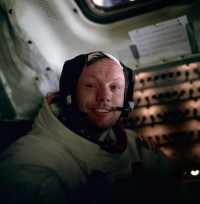 The checkout went smoothly, and the first sunrise was so spectacular that they wanted to get a picture of it. This led to a hunt for a missing Hasselblad camera that they finally corralled, too late to get the picture but well in time to keep it from doing damage during the TLI. At two hours and fifteen minutes into the flight, they received the go for TLI and put their helmets and gloves back on. This was supposed to protect them during the burn but Armstrong thought it would have hampered their ability to react to an emergency.
The checkout went smoothly, and the first sunrise was so spectacular that they wanted to get a picture of it. This led to a hunt for a missing Hasselblad camera that they finally corralled, too late to get the picture but well in time to keep it from doing damage during the TLI. At two hours and fifteen minutes into the flight, they received the go for TLI and put their helmets and gloves back on. This was supposed to protect them during the burn but Armstrong thought it would have hampered their ability to react to an emergency.
The burn went smoothly and the Saturn’s job was done. Michael Collins took control of the Columbia to separate it from the rocket. Then, he turned around to retrieve the Lunar Module, which they had named the Eagle. The Eagle was secured in a compartment on the Saturn to protect it during launch and this was where all the work on docking during the Gemini program came in handy. The maneuver went well though Collins had gone out a few feet more than he had planned while separating from the rocket. “Well, that wasn’t the best job I’ve ever done,” he told his crewmates. “Seemed fine to me,” answered Armstrong.
They could finally change out of their uncomfortable spacesuits and enjoy the ride. They didn’t really get an impression of speed because there was nothing outside to compare the position of their spacecraft to except the receding Earth and approaching Moon. Collins set the Columbia to do a slow roll to keep any point in the spacecraft from getting too hot or cold. It was tricky to get a perfect, rotisserie-style roll without any pitch or yaw action, but soon, they were getting alternating views of the Earth, sun and Moon through their window. They did some sight-seeing through a monocular and Armstrong described landmasses and weather patterns he recognized for the people back home.
They raided the pantry for their first meal in space. They could make sandwiches with tubed spreads that included ham, tuna, chicken salad and cheese or squeeze hot and cold water into packets of freeze-dried foods. Armstrong’s favorites included the spaghetti with meat sauce, scalloped potatoes, pineapple fruitcake cubes, and grape punch for the drink. They did have a grapefruit-orange citrus drink on board but Armstrong later went on record as saying that he didn’t think it was Tang.
After the meal, Collins settled into his seat to take the first watch while Armstrong and Aldrin pulled out mesh hammocks. They had fought drowsiness since before the TLI, leading Collins to quip, “You need to get out the alarm clock.” Adrenaline had kept them awake until this point and, even though it was beginning to wear off, they only managed to sleep for five and a half hours. They were already alert when Capcom Bruce McCandless gave them a wake-up call and the morning news. America was enthusiastic about their launch but the Soviets apparently weren’t. In one last act of defiance, they had launched a lunar probe called Luna 15. NASA was concerned that it might interfere with their mission but it would ultimately crash-land on the moon.
During the second day, there wasn’t much to do except some routine chores and an ultimately unsuccessful telescope experiment in which they tried to pinpoint a laser beam coming from an observatory near El Paso, Texas. Armstrong and Aldrin decided to check on the Eagle a day early to make certain it had taken no damage during the launch. They did have a bit of excitement when they saw a twinkling light outside their spacecraft. None of them could figure out what it was, and they didn’t want to tell Houston they were suddenly seeing UFOs. Armstrong radioed back, asking how far the Saturn was from them. The Capcom had to confer with somebody, and then answered, “It should be about 6,000 nautical miles away from you.” Armstrong thanked them and the crew decided it was probably one of the panels from the housing that had protected the lunar module.
They put on a live TV show for the Americans watching back home. It started out with Armstrong aiming the camera back at Earth and describing the view, and then Collins turned the camera upside down. “Okay, world, hang on to your hat. I’m going to turn you upside down.” Aldrin did a few push-ups and Collins demonstrated how to make chicken stew in zero G. Armstrong did a headstand and Collins quipped, “Neil’s standing on his head again. He’s trying to make me nervous.”
On July 19th, they got their first close-up view of the moon. The moon was between them and the sun, making for some interesting back-lighting. The Apollo 11 crew were being treated to their own, personal solar eclipse. They tried to get pictures, but no camera had yet been made to handle such unique lighting conditions and the quality of the pictures suffered for it. Collins thought the moon looked forbidding, while Armstrong described it as “a view worth the price of the trip.”
To make it into lunar orbit, the Columbia had to slow down with a precise engine firing called LOI-1, the first Lunar Orbit Insertion. The burn lasted six minutes and slowed their speed by 2,000 miles per hour. If they made a mistake, they could end up stuck in solar orbit. The burn lasted until they had swung behind the moon, making for some finger-biting nervousness back at Mission Control. For the first time, they didn’t have radio communications. Twenty-three minutes later, they reestablished contact: “That was a beautiful burn!”
They spent some time just looking down at the moon, picking out landmarks and debating about what color it was. Collins thought it looked like Plaster of Paris, light grey, and so did Armstrong at first. Then, it turned tan. The angle of the sun was making the difference. It looked different at “noon” than it did at “dawn” or “dusk.” Armstrong picked out the planned landing site and radioed back to Houston, “It looks very much like the pictures, but like the difference between watching a real football game and watching it on TV. There’s no substitute for actually being here.”
The crew reluctantly got in one last live TV show. They pointed out the planned route the Eagle would take and landmarks like Apollo 8′s “Mount Marilyn.” The Sea of Tranquility looked dark; Collins would later describe it as “distinctly forbidding.”
They made a seventeen-second burn to alter their orbit from a 168.8-by-54.4-mile ellipse to one that was 66.1 by 54.4 miles. That came within a few tenths of a mile of what they planned on and they were thrilled at the precision. Armstrong and Aldrin went to the Eagle for one last systems check. With a big day ahead of them on July 20, they hit the sack. Perhaps the adrenaline was beginning to kick in again and none of them got a lot of sleep.
The Landing
July 20, 1969
This morning, every American who could watch was glued to a television set for the live coverage. There had been telecasts about the symbolic and spiritual meaning of the first landing. Nervous NASA and White House staffers had prepared statements in case Neil Armstrong and Buzz Aldrin never made it off the moon. Armstrong and Aldrin were certainly so excited that the routine they had worked out for previous mornings in space “came unglued,” as Aldrin put it. Still, they managed to get breakfast together and then changed into the suits they would wear on the moon.
The Russians had dubbed Armstrong “The Czar of the Ship” and he was so quiet while they were checking out the Eagle that Collins asked, “How’s the czar over there?” Armstrong answered, “Just hanging on and punching [buttons].” As the minutes ticked down to the undocking, Collins told them, “You cats take it easy down there. If I hear you huffing and puffing, I’m going to start bitching at you.” Then he threw the switch to release the Eagle.
There is no video of the Eagle pulling away from the Columbia because Collins told Houston there was no room for a video camera at the window. Armstrong rotated the Eagle so Collins could get a good look at its bottom and make sure the landing gear was in position. “Looks like you’ve got a good looking flying machine there, Eagle, despite the fact that you’re upside down,” he told them. “Somebody’s upside down!” Armstrong joked back.
They began their descent with an engine firing called Descent Orbit Insertion (DOI). This was designed to drop their orbit to an altitude of 50,000 feet. Armstrong and Aldrin both kept an eye on their navigation systems. Their primary navigation was called the Primary Navigation, Guidance and Control System (PNGS), a digital computer that processed information from an inertial platform. The second, backup system was called the Abort Guidance System (AGS) and could be used if they had to return to the Columbia without landing. It used body mounted accelerometers for measurement. Apollo 10′s Lunar Module had run into problems with their navigation systems, causing it to go into some wild gyrations. That was the sort of thing they had to avoid.
They could only estimate their altitude at this point. The Eagle wasn’t oriented to use radar yet and it would have been inaccurate at this point anyway. The window that the Mercury astronauts had fought so hard to have included in spacecraft came in handy in situations just like this. Armstrong could eyeball the lunar surface and use the Eagle’s angular rate and velocity to make on-the-fly calculations about altitude. He came up with a figure of about 53,000 feet, within a few thousand feet of what the computer was saying, and received a “Go” for powered descent from Houston.
They activated an exterior camera that would allow Earth to watch the powered descent. The people waiting on the ground were tense even if the astronauts weren’t. Wally Schirra was acting as commentator for Walter Cronkite’s telecast and asked if he had thought about what he would say when they landed. The normally articulate Cronkite didn’t have an answer ready. Perhaps some listeners noticed that Aldrin seemed to be doing the talking for both of them as they approached the surface. Armstrong was completely focused on the job.
He adjusted the Eagle’s attitude so that the radar antenna was pointed at the moon. It turned out to be a good thing he did. The radar showed that they were almost 3,000 feet closer to the surface than the PNGS has indicated. While they rolled into an upright position, they got a magnificent view of a marble-sized Earth and then were able to pick out landmarks on the Moon. They were traveling down what had been dubbed “U.S. Highway 1″ in honor of the pre-Interstate Highway System road.
Then, a yellow light came on and Armstrong checked it. “Program alarm. It’s a 1202,” he told Houston. A 1202 error meant that the computer was receiving more data than it could handle at any given time. Eyebrows must have gone up in Mission Control. In one of the simulations they had run just before the mission, somebody had mistakenly called an abort on this exact same alarm. “We’re Go on that alarm,” Capcom told them. The 1202 light would flash two more times in the next four minutes, and then they got a 1201 error. “We’re Go. Same type. We’re Go,” Capcom told them.
They were getting close to the surface and, though Armstrong had studied images from automated lunar orbiters, he didn’t recognize any of the landmarks. They were approaching 500 feet above the surface. He didn’t like the look of the boulders, some of which were the size of Volkswagens, so he took manual control of the lunar module to look for a more open area. Aldrin kept a careful eye on fuel, as did the people in Mission Control. At one point, Aldrin warned him, “Quantity light.” The fuel level dropped below 5 percent of their original load. They were approaching the point where they would either have to commit to landing, or abort. Armstrong finally spotted a good place and began the final descent, kicking up some dust. They landed with thirty seconds of fuel to spare.
Armstrong reported, “Houston, Tranquility Base here. The Eagle has landed.”
Capcom was so excited that he stammered a bit, “Roger, Twan… Tranquility. We copy you on the ground. You’ve got a bunch of guys about to turn blue. We’re breathing again. Thanks a lot.”
The EVA
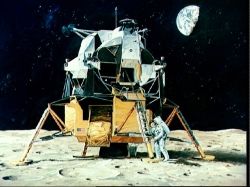 There were still a few issues that might prevent them from staying on the Moon. One of them was the issue of mascons, “mass concentrations,” that were believed to be deposits of very dense matter. Another was the fact that their landing area was on the sunlit side of the moon. Temperatures could get high enough to overheat the hydraulics system and cause pipes to burst. They solved that problem by venting the fuel and oxidizer tanks. The mission rules included three Stay/NoStay times. T-1 was two minutes after the landing and T-2 was eight minutes after T-1. T-3 would come two hours later, when the Columbia was overhead again. In case something went wrong and they had to get out of there, they went through most of the procedure of a normal takeoff to make certain everything worked okay.
There were still a few issues that might prevent them from staying on the Moon. One of them was the issue of mascons, “mass concentrations,” that were believed to be deposits of very dense matter. Another was the fact that their landing area was on the sunlit side of the moon. Temperatures could get high enough to overheat the hydraulics system and cause pipes to burst. They solved that problem by venting the fuel and oxidizer tanks. The mission rules included three Stay/NoStay times. T-1 was two minutes after the landing and T-2 was eight minutes after T-1. T-3 would come two hours later, when the Columbia was overhead again. In case something went wrong and they had to get out of there, they went through most of the procedure of a normal takeoff to make certain everything worked okay.
Everything looked fine, and they received the Stay decisions for T-1 and T-2. They continued systems checks until after T-3, and then Armstrong took advantage of a free moment to look outside. The area looked like it had gotten pummeled by several truckloads of pebbles, with miniature craters ranging from one foot to fifty feet across. There were a few ridges between twenty and thirty feet high and a hill that Armstrong estimated was about a mile away. Everything appeared to be various shades of grey.
The plan was for the first Moonwalkers to take a four-hour nap before the EVA. They were too excited to sleep and Armstrong gave up readily enough: “Okay, let’s get on with it.” They ate a planned meal and did some housekeeping chores, and then donned gloves, helmets and backpacks for the trip outside. They had to watch it because a stray elbow could have damaged the thin walls of the Eagle. They did damage a circuit breaker they needed for liftoff and Aldrin was able to solve the problem later using a felt-tip pen. As it turned out, it was pretty cramped in the Lunar Module with their suits on and it was very possible that Armstrong would have had to be the first out anyway.
They depressurized the cabin and opened the hatch. Armstrong had his mind on the job and nearly forgot to deploy the camera used to transmit video back to Earth. Houston reminded him and he pulled the deployment handle. Houston confirmed that they were getting a picture, but it was upside down! They were able to solve that problem, and Armstrong took the first step down the ladder.
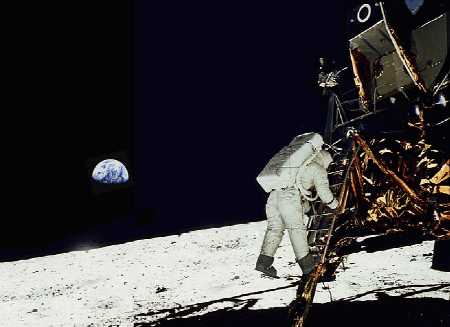 Capcom confirmed: “Okay, Neil, we can see you coming down the ladder now.”
Capcom confirmed: “Okay, Neil, we can see you coming down the ladder now.”
Armstrong: “Okay, I just checked getting back up to that first step, Buzz. The strut isn’t collapsed too far, but it’s adequate to get back up. … It takes a pretty good little jump.”
A few seconds later, “I’m at the foot of the ladder. The LM footpads are only depressed in the surface about one or two inches, although the surface appears to be very fine-grained as you get close to it. It’s almost like a powder. The ground mass is very fine.
“I’m going to step off the LM now.”
A moment later, Armstrong put the very first footprint on the Moon and uttered the words that would be forever remembered.
That’s one small step for man, one giant leap for mankind.
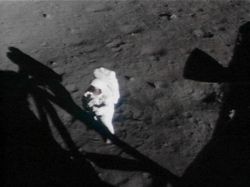 Aldrin sent a camera out to Armstrong using the Lunar Equipment Conveyor (LEC). The LEC reminded the astronauts of a Brooklyn-style clothesline and proved convenient for sending equipment in and out of the lunar module. Armstrong got busy taking pictures and had to be reminded to take a contingency sample of the lunar soil. He used a Pooper Scooper-like device to collect soil and rocks and put the removable bag in a pocket on his leg.
Aldrin sent a camera out to Armstrong using the Lunar Equipment Conveyor (LEC). The LEC reminded the astronauts of a Brooklyn-style clothesline and proved convenient for sending equipment in and out of the lunar module. Armstrong got busy taking pictures and had to be reminded to take a contingency sample of the lunar soil. He used a Pooper Scooper-like device to collect soil and rocks and put the removable bag in a pocket on his leg.
He took a moment to describe the landscape. “It has a stark beauty of its own. It’s much like the high desert of the United States. It’s different, but it’s very pretty out here.” Out of curiosity, he took the ring that had been holding the sample bag to the sample collector and threw it to see how far it would go. Alan Shepard might have been the first to golf on the moon, but Neil Armstrong was the first to throw a pitch. Aldrin teased, “Didn’t know you could throw so far.” Armstrong agreed, “You can really throw things a long way up here!”
Now it was Aldrin’s turn to climb down the ladder. He climbed down to the last rung once, and then went up to partially close the hatch: “Making sure not to lock it on my way out!” “A particularly good thought,” Armstrong laughed. If the Lunar Module began to repressurize while they were outside, they would have had trouble getting the door back open. As Aldrin put it later, “Well, you’d get it open, but you’d never get the bent hatch closed again!”
They tried out different gaits, testing their mobility, and Armstrong’s family watching back home were impressed by how well they moved around with those bulky suits on. His mother worried that he might fall over and tear something, putting a quick end to his fun. Armstrong did try jumping a few times and found out that his backpack made a difference in his center of mass when he almost fell over backwards.
 They detached and set up the plaque that had been attached to the Eagle‘s ladder leg. It displayed two hemispheres representing Earth and the inscription, “Here Men from the Planet Earth first set foot upon the Moon, July 1969 A.D. We came in peace for all mankind.” It was signed by the Apollo 11 crew members and the President of the United States.
They detached and set up the plaque that had been attached to the Eagle‘s ladder leg. It displayed two hemispheres representing Earth and the inscription, “Here Men from the Planet Earth first set foot upon the Moon, July 1969 A.D. We came in peace for all mankind.” It was signed by the Apollo 11 crew members and the President of the United States.
The next item on their list was setting up the American flag. There had been a considerable amount of debate about whether to use a U.S. or United Nations flag and Armstrong had simply decided not to worry about it. They hadn’t done a lot of rehearsing for the flag ceremony and it turned out to be more difficult than they had imagined. The moon dust wasn’t very thick and they had trouble sticking the flag staff deep enough to hold it upright. They finally managed it and extended the telescoping arm that was supposed to hold the flag out at a ninety-degree angle to the staff. It wouldn’t extend fully; the result was that the flag looked like it was waving. Neil Armstrong got a picture of Aldrin saluting the flag, and then they were both distracted by a call from Houston and Aldrin never got a picture of Armstrong with the flag.
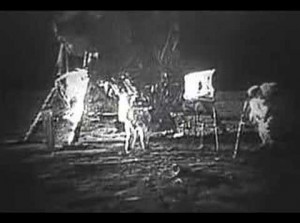 Houston wanted them both in front of the camera for a call from President Nixon. Slayton had told Armstrong that they might get a special call but didn’t say that it would be from the President. For Aldrin, it was a complete surprise.
Houston wanted them both in front of the camera for a call from President Nixon. Slayton had told Armstrong that they might get a special call but didn’t say that it would be from the President. For Aldrin, it was a complete surprise.
Nixon came on. “Hello, Neil and Buzz. I’m talking to you by telephone from the Oval Room in the White House, and this certainly has to be the most historic telephone call ever made. I just can’t tell you how proud we all are of what you have done. For every American, this has to be the proudest day of our lives. And for all people all over the world, I am sure they, too, join with Americans in recognizing what an immense feat this is. Because of what you have done, the heavens have become a part of man’s world. And as you talk to us from the Sea of Tranquility, it inspires us to redouble our efforts to bring peace and tranquility to Earth. For one priceless moment in the whole history of man, all the people on this Earth are truly one, one in their pride in what you have done, and one in our prayers that you will return safely to Earth.”
Armstrong answered, “Thank you, Mister President. It’s a great honor and privilege for us to be here representing not only the United States but men of peace of all nations, and with interests and the curiosity and with the vision for the future. It’s an honor for us to be able to participate here today.”
Nixon: “And thank you very much, and I look forward, all of us look forward to seeing you on the Hornet on Thursday.
Aldrin got the last word in. “I look forward to that very much, sir.”
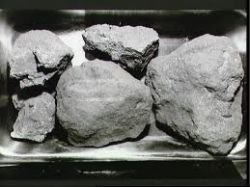 Nixon got off the line and the two astronauts got back to work. They collected the bulk sample of soil and rocks, anything that looked like it might be reasonably useful to geologists. They would bring back 21.7 kilograms of samples. Most of the rock was basalt and some of it had been formed 3.7 billion years ago. Not much of it has actually been studied and some of it wound up in museums. A few of the samples collected during the Apollo lunar landings were named: “Great Scott,” “Rusty Rock,” and “The First Apollo 11 Sample Analyzed” are immediately recognizable to many exogeologists.
Nixon got off the line and the two astronauts got back to work. They collected the bulk sample of soil and rocks, anything that looked like it might be reasonably useful to geologists. They would bring back 21.7 kilograms of samples. Most of the rock was basalt and some of it had been formed 3.7 billion years ago. Not much of it has actually been studied and some of it wound up in museums. A few of the samples collected during the Apollo lunar landings were named: “Great Scott,” “Rusty Rock,” and “The First Apollo 11 Sample Analyzed” are immediately recognizable to many exogeologists.
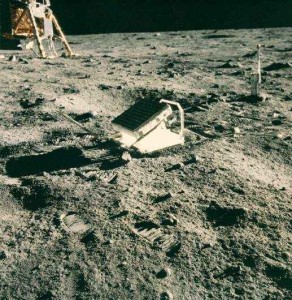 They deployed experiments like the Solar Wind Composition Experiment, meant to capture charged particles from the sun, and the Passive Seismometer Experiment, designed to pick up moonquakes. The LRRR would provide more accurate measurements of the distance between the Earth and the Moon. This device acted funny at first; the bubble that was supposed to indicate when it was aligned kept wandering around but would eventually stabilize. Armstrong thought it was an effect of the lower gravity on the Moon.
They deployed experiments like the Solar Wind Composition Experiment, meant to capture charged particles from the sun, and the Passive Seismometer Experiment, designed to pick up moonquakes. The LRRR would provide more accurate measurements of the distance between the Earth and the Moon. This device acted funny at first; the bubble that was supposed to indicate when it was aligned kept wandering around but would eventually stabilize. Armstrong thought it was an effect of the lower gravity on the Moon.
Both Aldrin and Armstrong took pictures throughout. Mysteriously, Aldrin took very few pictures of Armstrong on the Moon. Armstrong certainly had the camera for most of the time and perhaps neither of them thought of getting a good shot. One rumor floating around was that Aldrin did think of it, but retaliated for not being first on the Moon by not taking many pictures of Armstrong. He denied it, and other astronauts believed that they were both so busy with their duties that it seemed a minor issue at the time.
Near the end of the planned EVA, Armstrong decided to check out a crater he had gotten curious about. He ran over as well as he could with a bulky EVA suit, reaching a top speed of two miles per hour, and took pictures. The crater came to be dubbed “East Crater” and showed outcroppings that he thought might be interesting to the geologists. They finished up the core samplings and Aldrin was up in the Eagle first. Armstrong followed ten minutes later. He would have liked to have more time on the surface to explore. He began closing up the sample containers and sending them up the LEC. This took more effort than he anticipated and his heart rate soared to the point that Mission Control became alarmed. They disguised a request to slow down by asking him for readouts of tank pressure and oxygen in the EMU.
Just before returning to the Eagle, Armstrong reminded Aldrin of a “package” in his sleeve. It contained mementos such as a patch commemorating the Apollo 1 crew, two honoring deceased Russian Cosmonauts Yuri Gagarin and Vladimir Komarov, and an olive branch pin representing the peaceful nature of their mission. They were going to have a brief ceremony, but ran out of time, so Aldrin tossed it out the door. Then, Armstrong jumped up to the third rung of the ladder and climbed inside. He had to lean backwards a little to make it inside. Barely a minute later, Aldrin confirmed, “Okay. The hatch is closed and latched, and verified secured.”
Back In the Eagle
 Armstrong and Aldrin repressurized the Eagle and shed their spacesuits, and then checked the readouts on the control panel. Everything looked fine, so they moved on to stowing extraneous items in a large trash bag to be left on the lunar surface. They used their second camera to snap pictures of what they could see out the windows: the flag, the Earth, the TV stand they had used to send live video back to Earth. Then, they had their second meal on the lunar surface and Deke Slayton sent them a message of congratulations.
Armstrong and Aldrin repressurized the Eagle and shed their spacesuits, and then checked the readouts on the control panel. Everything looked fine, so they moved on to stowing extraneous items in a large trash bag to be left on the lunar surface. They used their second camera to snap pictures of what they could see out the windows: the flag, the Earth, the TV stand they had used to send live video back to Earth. Then, they had their second meal on the lunar surface and Deke Slayton sent them a message of congratulations.
They suited up and depressurized the cabin one last time, but only so they could toss the trash bag and the backpacks outside. The sensitive seismometer picked up the impacts. One thing they couldn’t get rid of so easily was the lunar dust they had brought in with them. It clung to their spacesuits and got tracked in. They had to be careful because it could have been flammable.
They answered a few questions from the science and engineering people, and then Armstrong called a halt to it so they could get some sleep. Armstrong and Aldrin had both been awake for twenty-two hours. As tired as they must have been, sleeping in the cramped cabin wasn’t easy. Aldrin slept on the floor and Armstrong slept on the engine cover with his feet supported by a sling, neither of which was very comfortable. Armstrong mostly dozed and got only two hours of restful sleep out of the seven hours scheduled.
They received their wake-up call at about 9:30 A.M. CDT and began going over preparations for departing from the moon. Armstrong answered a complex geological question one of the scientists had asked last night. Shortly after noon, they were ready to leave.
Liftoff From The Moon
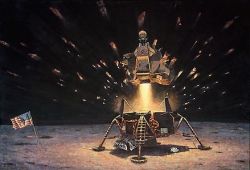
This was one of the most tense moments of the entire Apollo program. There was a chance that the engine would not fire and Neil Armstrong and Buzz Aldrin could become permanent fixtures on the Sea of Tranquility. Even once they made it into orbit, things could go wrong and Michael Collins had worked out several scenarios, including ones in which he had to chase down the Eagle.
The engine functioned perfectly, scattering highly reflective bits of insulation and knocking over the American flag. Alan Bean, the unofficial astronaut-artist of the Apollo Program, would later dramatically capture the moment in the above picture. The Eagle tilted forward by forty-five degrees. This was expected and the astronauts were secured by springs and straps. Aldrin described it as “a very quiet ride.”
A glance out the window revealed that they were going back along “U.S. 1.” It took seven minutes for them to get back up into orbit. Collins was the most nervous of the three. The two rendezvous maneuvers he had performed for Gemini X had not gone as planned and he was afraid of returning to Earth without his two comrades. When he heard that they had made it into a low orbit with a perilune of 9.1 nautical miles and apolune of 47.2 nautical miles, it was his turn to start breathing again. It would be three more hours before they made the rendezvous.
Rendezvous and Docking
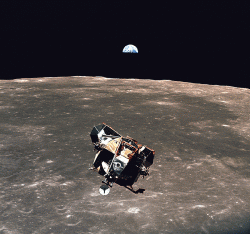 Armstrong’s Gemini experience served him well here. The principles of orbital mechanics worked in lunar orbit as well as they did in Earth orbit. Because they were still at a lower altitude than the Columbia, the Eagle was moving faster. They made two burns of the reaction control system engines (RCS) to ascend to a higher orbit and then get into a closer plane with the command module. They were gradually catching up with the Columbia. A third burn brought them into an intercept course with their goal.
Armstrong’s Gemini experience served him well here. The principles of orbital mechanics worked in lunar orbit as well as they did in Earth orbit. Because they were still at a lower altitude than the Columbia, the Eagle was moving faster. They made two burns of the reaction control system engines (RCS) to ascend to a higher orbit and then get into a closer plane with the command module. They were gradually catching up with the Columbia. A third burn brought them into an intercept course with their goal.
Things were going well so far, and they started to joke around with each other. “Well, I see you don’t have any landing gear,” Collins said. Armstrong shot back, “That’s good. You’re not confused on which end to dock with, are you?” A few minutes later, Armstrong spotted two bright lights next to each other. “One of those two bright spots is bound to be Mike.” Aldrin said, “How about picking the closest one?” “Good idea.”
Another burn brought the Eagle into formation with Columbia. Collins turned Columbia into position for docking and Armstrong rotated the Eagle. They had been on the far side of the Moon and now re-established contact with Houston.
Capcom did some fishing for information, “Eagle and Columbia, standing by.”
Armstrong was irritated by this untimely intrusion, “Roger. We’re station keeping.”
He gradually nudged the Eagle toward Columbia and, when they met, they promptly ran into a nasty condition known as gimbal lock. Two of the gimbals of the inertial platform got aligned and couldn’t move. This caused some of the attitude jets to fire and the lunar module heaved around to one side. Collins had to swing the command module around to compensate. The lunar module calmed down and they were able to complete the docking.
Aldrin was out first, and then Armstrong, both with big grins on their faces. They danced around a little in celebration, and then started transferring samples from the lunar module. Once that was done, Collins flipped the switch to jettison the lunar module. It would spend a few years in a gradually decaying orbit until it crashed. Houston gave the “Go” for the Trans-Earth Injection that they would perform on their last swing to the far side of the Moon. The trip home was a pretty sharp anticlimax and, two and a half days later, they splashed down and were retrieved by the Hornet.
On The Hornet
Quarantine
 Some people were concerned that the Apollo 11 crew might inadvertently bring back a lunar germ. Perhaps part of it was fueled by a science fiction tale called The Andromeda Strain. In any case, to reduce the risk, NASA came up with the Biological Isolation Garments (BIG) to throw into the command module for the crew to wear until they could transfer to the Mobile Quarantine Facility on the Hornet. The frogmen on the rescue team also sprayed them with disinfectant as they emerged from the module.
Some people were concerned that the Apollo 11 crew might inadvertently bring back a lunar germ. Perhaps part of it was fueled by a science fiction tale called The Andromeda Strain. In any case, to reduce the risk, NASA came up with the Biological Isolation Garments (BIG) to throw into the command module for the crew to wear until they could transfer to the Mobile Quarantine Facility on the Hornet. The frogmen on the rescue team also sprayed them with disinfectant as they emerged from the module.
A helicopter took them to the Hornet and they went straight into the quarantine facility, where they would spend the next month. Nixon was there, along with Secretary of State William Rogers and NASA Administrator Thomas Paine. The astronauts waved to a gathering of sailors they could barely see.
Once they were safely inside the quarantine facility, one of NASA’s physicians, Doctor Carpentier, took microbiology samples and ran them through the usual post-mission physical. He would stay in quarantine with the crew. They took a quick shower, and then gathered at a window so they could take part in the planned ceremonial activities with Nixon.
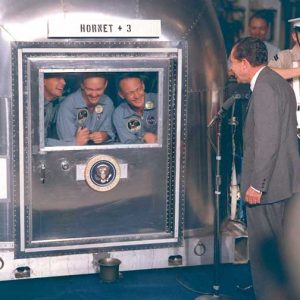 Nixon made a speech, joked about how he had made the phone call to the moon collect, and invited them to a state dinner in their honor when they got out of quarantine. He exaggerated a little bit about the importance of the moon landing, calling it “the greatest week in the history of the world since the Creation.”
Nixon made a speech, joked about how he had made the phone call to the moon collect, and invited them to a state dinner in their honor when they got out of quarantine. He exaggerated a little bit about the importance of the moon landing, calling it “the greatest week in the history of the world since the Creation.”
Afterwards, there were more medical exams, and then had an impromptu celebration. Armstrong had a scotch with the crew’s dinner of grilled steaks and baked potatoes. They had some sleep to catch up on and hit the sack for nine hours. The Apollo 11 crew passed the two days on the Hornet playing cards, reading and signing autographed pictures.
They weren’t in much of a position to view the throngs of people gathered at Pearl Harbor. Admiral John McCain (father of the senator) greeted them with a gruff, “You lucky sons of bitches. I’d have given anything to go with you.” The quarantine facility was loaded on a flatbed truck and driven, far too slowly for their taste, to Hickam Field and a waiting plane appropriately called the C-141 Starlifter.
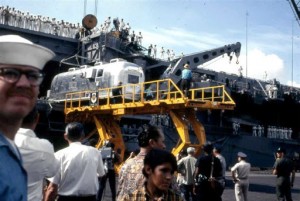 They landed at Ellington Air Force Base and it took three tries to load them on another truck. A crowd of several thousand people and several television cameras awaited them. So were their wives and children, who they talked to on a telephone hookup. Houston mayor Louis Welch and Bob Gilruth spoke with them. They made it to the Lunar Receiving Laboratory a little after 2:30 A.M. They were joined by two cooks, a janitor, another doctor, a journalist, and a young woman who had managed to get herself exposed to some samples. The crew had protested the journalist to no avail and didn’t particularly like the circumstances behind the inclusion of the lady.
They landed at Ellington Air Force Base and it took three tries to load them on another truck. A crowd of several thousand people and several television cameras awaited them. So were their wives and children, who they talked to on a telephone hookup. Houston mayor Louis Welch and Bob Gilruth spoke with them. They made it to the Lunar Receiving Laboratory a little after 2:30 A.M. They were joined by two cooks, a janitor, another doctor, a journalist, and a young woman who had managed to get herself exposed to some samples. The crew had protested the journalist to no avail and didn’t particularly like the circumstances behind the inclusion of the lady.
Armstrong got the chance to talk with his mother and kidded that he hadn’t gotten a chance to take a shower yet. He also commented about all the lunar dust getting all over their nice, clean space suits. Though his crewmates were frustrated at being cooped up, he seemed to recognize that their time in quarantine was simply the calm before the storm and accepted the respite, temporary as it was. They certainly had enough to occupy them, with debriefings and answering questions from the astronauts who would make the next lunar landings. Armstrong celebrated his thirty-ninth birthday while still in quarantine. Despite an oblique warning from Jim Lovell, Armstrong underestimated the reaction from the American public. His life would never be the same again.
Apollo 11 Press Conference
Moon Landing Myths
And, of course, there are a number of myths related to both Neil Armstrong and the first moon landing. Did they see UFOs? What about that Bart Sibrel character? Find out more about Moon Landing Myths here. A few of them are addressed in the above blog post.
After The Moon
Almost as soon as the crew got out of quarantine, they were bombarded by paparazzi and curiosity-seekers. The legitimate press had agreed to stay away but that didn’t stop some photographers from ambushing them at their house or chasing them when they tried to go out. Armstrong went straight into his home and firmly closed the door. He spent most of his first day home answering mail that had piled up while he was in quarantine.
They had a post-mission press conference with questions about the 1202 and 1201 alarms, the fuel situation, and their long landing. Asked about difficulties involved with the EVA, Armstrong commented, “We had the problems of a five-year-old boy in a candy store. There were just too many things to do.” Early the next morning, the astronauts and their families took off in Air Force Two for a one-day, three-city tour. The parade in New York City set an attendance record of four million people and their car was damaged by thrown IBM punch cards. Events were even crazier in Chicago, if that was possible. There was so much confetti that the crew was covered in it. It was a hot day and they were perspiring, causing some of it to stick.
In Los Angeles, the kids were treated to hamburgers, French fries and malt shakes in their Century Plaza Hotel room while the astronauts and their wives were whisked off to the state dinner with Nixon. Notables included most of the Cabinet members, forty-four state governors, rocket pioneer Robert Goddard’s widow, several prominent Republicans in Congress, international dignitaries representing the United Nations, and aviation and space pioneers Jimmy Doolittle, Wernher von Braun and Willy Messerscmitt. Conspicuously missing were legendary aviators Charles Lindbergh and Howard Hughes. They had been invited but chose not to come. The Kennedys also couldn’t attend. They were dealing with a fatal accident Senator Ted Kennedy had been involved in. Armstrong gave a heartfelt speech in which he described a sign he had noticed in one of the parades, “Through you, we touched the Moon.” The event was marred only by anti-war protesters staked outside the hotel.
Houston welcomed them back with a ticker-tape parade and a Texas barbecue with 55,000 attendees. Frank Sinatra was the master of ceremonies and performers included singer Dionne Warwick and comedian Bill Dana. The crew made appearances for NBC’s Meet the Press and CBS’s Face the Nation. Armstrong was openly optimistic about the future of America in space and contemplated a trip to Mars.
Wapakoneta got into the act with their own gala, in which streets were temporarily renamed “Lift-Off Lane,” “Apollo Drive” and “Eagle Boulevard.” Bob Hope put in an appearance with a string of jokes about Neil Armstrong: “He keeps throwing his shoes out the window and eating his toothpaste!” Governor Rhodes announced plans to build the Neil Armstrong Museum in Wapakoneta. Addressing the crowd, Armstrong commented that though they had officially found no organic substances on the moon, “I think you know better now. There was a Buckeye on the Moon.” Even though Neil Armstrong would later gain a reputation as not being very good at telling jokes about the Moon, the crowd loved it.
Around the World
Armstrong gave a speech to a joint session of Congress, and then they were off on a hectic world tour that included stops in more than 25 cities. He kept a tape-recorded travelogue and his wife remembered having “a wonderful trip.” The Aero Club of France presented them with a gold medal, a rare honor for Americans. They came down with colds and laryngitis shortly before their stop in London and had to cancel two TV programs. Doctor Carpentier stepped in, pleading exhaustion on their behalf.
The tour ended in Washington, D.C. and attended a reception held by President Nixon. When asked what his plans for the future were, Armstrong answered that he had no specific plans but would be honored to serve as an ambassador.
Armstrong then joined Bob Hope’s Christmas 1969 USO tour. Bob Hope maintained that Armstrong turned out to be the star. He would come out at the end of the show and hold a question-and-answer session. Even after the show, the GIs who would normally be seen trying to get autographs and pictures with Hope’s girls were more likely to want to get a minute with Armstrong. Armstrong was more modest about it: “I don’t think so! He was always making the jokes.” It did cause him some trouble because he was seen with actress Connie Stevens and some of the astronauts had a reputation for philandering that dated back to the Mercury days. He maintains that they did nothing more serious than play cards.
He visited Russia in May 1970 and, for once, there was no crowd. His hosts were two cosmonauts named Georgy Beregovoy and Konstantin Feoktistov. He spent five days in Leningrad and then travelled to Moscow, where he presented Premier Alexei Kosygin with some chips of a Moon rock and a Soviet flag that had been carried to the Moon. Kosygin later sent Armstrong a case of Cognac and vodka. He visited the Kremlin’s Armory Museum, where he was informed that one of czarist Russia’s crown jewels was worth $300 million. He quipped back, “I think I’ll wait until they sell it at half price.” He also got to tour the Cosmonaut Training Center at Star City and met Valentina Tereshkova, the first woman in space, and the widow of the legendary Yuri Gagarin, the first man in space. Tereshkova later commented that his smile reminded her of Gagarin’s. He attended a dinner in which he was presented with a twelve-gauge, double-barrel shotgun and viewed a taped recording of the launch of Soyuz IX.
When he got back, he took on a position as NASA’s deputy associate administrator of aeronautics for the Office of Advanced Research and Technology. His principle contribution was his support for a digital fly-by-wire system rather than the proposed analog system. The very next summer, he resigned and moved on to the next stage of his life.
University of Cincinnati
As an American hero, he could have had his pick of any number of opportunities in the private business world or go into politics. Over the years, rumors circulated that he could challenge John Glenn for a Senate seat or help Nixon’s bid for re-election. However, the idea of going into university life appealed to him and he got several offers to become a president. He met with University of Cincinnati president Walter C Langsam and they hit it off well. Langsam offered him a chance to become the professor of aeronautical engineering and he accepted. Some people wondered about his choice and there was speculation that the chance to return to his home state was a factor.
The department was a small one and it was a challenge to find teachers. Armstrong took on some of the core courses and created two advanced courses: aircraft design and experimental flight mechanics. One of the downsides was the fact that reporters frequently showed up on campus, hoping for an interview. On the first day of class, the hall was so packed with reporters that getting out of the classroom was a challenge. Armstrong refused to cooperate and closed the door. Some of the students happily answered questions, while others snapped, “He’s just another person now, just another professor. Give him a break.” But they found Armstrong to be a very good teacher.
In the end, the world of university politics forced him out. Collective bargaining imposed some new rules that Armstrong disliked and, to avoid them, he went to half-time, though he commented, “What it really amounted to was half pay.” Even then, he couldn’t completely escape the changes being made at the university and resigned after the Autumn 1979 semester.
The World of Business
He was still receiving offers from several companies and made a deal with Chrysler to be their spokesperson. He took some board positions with companies involved in technology and avionics and did some test-flying for Learjet, once setting an altitude record and a climb record for business jets. He turned down more offers than he accepted and was unlikely to accept any offer that seemed to stem strictly from the fact that he was the first man to set foot on the Moon.
Business trips would occasionally lead to entertaining moments. He was on the board of Taft Broadcasting and was traveling to the Cape with the CEO, Charles Mechem, when he realized he had forgotten his ID. They were worried that nobody would believe he was Neil Armstrong, but the first security guard they met said, “Oh, you’re Neil Armstrong, aren’t you?” “Yes! Yes, he is!”
Another time, the board of directors for Taft was holding a photo session and the photographer cracked everybody up when he said, “Mr. Armstrong, would you take one small step forward?”
Visiting the Taft-owned Kings Island, Armstrong was asked which rides he would like to try. He answered, “Nothing that’s too dangerous.”
He joined Thiokol, which manufactured the space shuttle’s solid-rocket boosters, three years after the Columbia disaster. Thiokol had taken a huge hit in credibility with that disaster and Armstrong helped them recover.
Though he never bragged about it, he did get involved in some charitable work. He headed Ohio’s Easter Seal campaign in 1973, served on the board of the Cincinnati Board of Natural History from 1976 to 1985, co-chaired the Charles A. Lindbergh Memorial Fund, and did some fund-raising for the Purdue University Foundation.
“The Hermit of Cincinnati”
Neil Armstrong was rapidly gaining a reputation for being a recluse, mostly fueled by members of the press who were having a frustrating time getting anything out of him. Newspapers dubbed him “Cincinnati’s Invisible Hero” and “The Hermit of Cincinnati.” One cartoonist drew an image of him in a spacesuit and a brick wall hiding his face. The question of whether he would ever return to the public arena was often answered, “Not if he can help it.” Astronaut Gordon Cooper once commented on how Armstrong had chosen to leave NASA rather than help them “milk the event for all the goodwill possible.” Others remembered how the press had hounded many of the early astronauts and were more forgiving.
Armstrong’s typical answer ran along the lines of, “I’d be harassed all the time if I wasn’t reclusive.” He did receive many invitations to attend events, press conferences and so on, and accepted as many as he felt he could reasonably do. He flatly refused to participate in anything that smelled of human-interest stories or anything that might be twisted into something he disapproved of. That meant more press conferences than one-on-one interviews. He was often photographed at civic functions around Ohio and typical headlines read, “Armstrong Says We Need Space” (Cincinnati Post, May 1978) or “Former Astronaut Supports [missile defense program] Star Wars” (Florida Today, Oct. 19, 1985).
Some newspapers were so eager for news that they pounced when Armstrong had an accident on his farm in Lebanon, Ohio, and severed a finger on his left hand. He was taken to a hospital in Louisville, Kentucky, which reattached his finger. He didn’t think it was so newsworthy: “Like all of us, I suppose, I incur routine injuries along the way.”
The idea that Armstrong wasn’t helping support the space program was also false. At the request of President Ronald Reagan, he took part in a commission that studied the potential of an ambitious fifty-year space plan. The plan was never implemented. He also helped investigate the Challenger disaster, taking charge of the operational side of the Accident Investigation Commission. He successfully pushed for combining related or redundant items in the final report.
While he was still at the University of Cincinnati, a lot of fan mail came through the campus post system and they had to hire a couple more secretaries to deal with it all. After he left, he hired a private secretary to help with the mail. He wrote a few form letters that could handle most requests and signed autographs until 1999, when he found out that people were selling them online and much of what was for sale were fakes. For a while, he also sent congratulatory letters to boys who attained the rank of Eagle Scout but then decided it sent the wrong message. By changing his mind, he helped drive up the value of his signature and earned the irritation of honest collectors. Unfortunately, not even his reclusive nature could protect him from the more rabid pursuers, and not all of them were his fans.
Ambushed by the Moon Hoaxers
The puncher in the above video is Buzz Aldrin, but many astronauts went on record as agreeing with the sentiment. Sometimes letters came to Neil Armstrong addressing the subject of whether Apollo 11 really did go to the Moon. One of Armstrong’s form letters addressed the Moon Hoax directly. Armstrong didn’t really like the conspiracy theory. In fact, he was quite offended by a program on FOX that implicated that several astronauts, including the Apollo 11 crew, had been accomplices in the murder of the Apollo 1 astronauts rather than let them release evidence of the hoax.
One prominent Moon Hoaxer named Brett Sibrel attempted to turn the issue into a media event and partially succeeded. A Youtube search for “Buzz Aldrin punch” turns up videos of the fellow provoking Buzz Aldrin into belting him. He ambushed Armstrong on several occasions, including at an EDO Corporation stockholder meeting in which he shouted, “Neil Armstrong, will you swear on this Bible that you went to the Moon?” It created a scene and the man was escorted out.
He actually went to Armstrong’s house on several occasions. Once, he frightened Armstrong’s wife by showing up at the door with a big dog and handing her a package for him. He continued to leave packages and letters at the front door. Armstrong turned them all over to the police. A neighbor tipped him off about a strange car parked outside the property. The fellow was shooting video of Armstrong’s activities around the property. That was the last straw and sparked a police car chase.
Neil Armstrong Receives Congressional Gold Medal
On July 21, 2009, Neil Armstrong, Buzz Aldrin, Michael Collins and John Glenn received the Congressional Gold Medal. These are Neil Armstrong’s remarks.
Retirement
 Such events were an unpleasant but inevitable part of his celebrity. Another price was, unfortunately, his marriage to Janet. She had finally gotten sick of being the wife of the First Man on the Moon and of him being gone all the time and filed for divorce. It was devastating to Neil Armstrong, but that and the fact that he had a heart attack on the slopes of Snowmass in early 1991 helped convince him to slow down. In 1992, he met his second wife, Carol, at a special event. At the time, he had no way of knowing that it had been secretly arranged by mutual friends. He made excuses to come out and see her and they were married in 1994. He retired from business in 2002. He continued to fly airplanes at every opportunity and owned a Cessna 310 for a while.
Such events were an unpleasant but inevitable part of his celebrity. Another price was, unfortunately, his marriage to Janet. She had finally gotten sick of being the wife of the First Man on the Moon and of him being gone all the time and filed for divorce. It was devastating to Neil Armstrong, but that and the fact that he had a heart attack on the slopes of Snowmass in early 1991 helped convince him to slow down. In 1992, he met his second wife, Carol, at a special event. At the time, he had no way of knowing that it had been secretly arranged by mutual friends. He made excuses to come out and see her and they were married in 1994. He retired from business in 2002. He continued to fly airplanes at every opportunity and owned a Cessna 310 for a while.
 Neil Armstrong passed away on August 25, 2012 of complications related to heart surgery and was buried at sea on September 13 in a traditional Navy ceremony. Though he modestly stayed out of the public eye, he will always be remembered as an American space icon. Whenever you see the moon, don’t forget to wink at it in memory of Neil Armstrong.
Neil Armstrong passed away on August 25, 2012 of complications related to heart surgery and was buried at sea on September 13 in a traditional Navy ceremony. Though he modestly stayed out of the public eye, he will always be remembered as an American space icon. Whenever you see the moon, don’t forget to wink at it in memory of Neil Armstrong.
NASA Remembers Neil Armstrong
Neil Armstrong Memorial Service
At the Armstrong Air & Space Museum, Wapakoneta, Ohio
The Official Neil Armstrong Biography
Neil Armstrong on eBay
[ebayfeedsforwordpress feed=”http://rest.ebay.com/epn/v1/find/item.rss?keyword=%28Neil+Armstrong%2CNeil+Armstrong+astronaut%29&sortOrder=BestMatch&programid=1&campaignid=5337337555&toolid=10039&listingType1=All&lgeo=1&feedType=rss” items=”5″]


